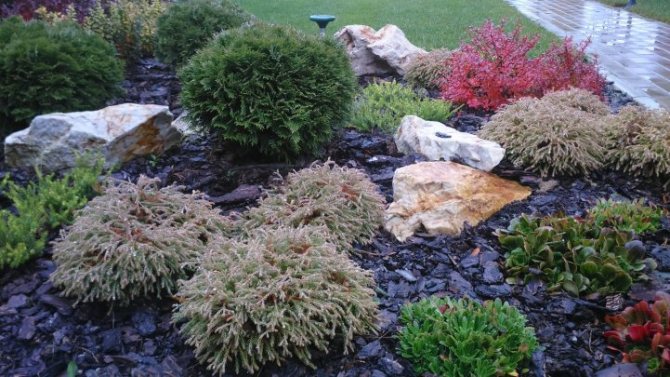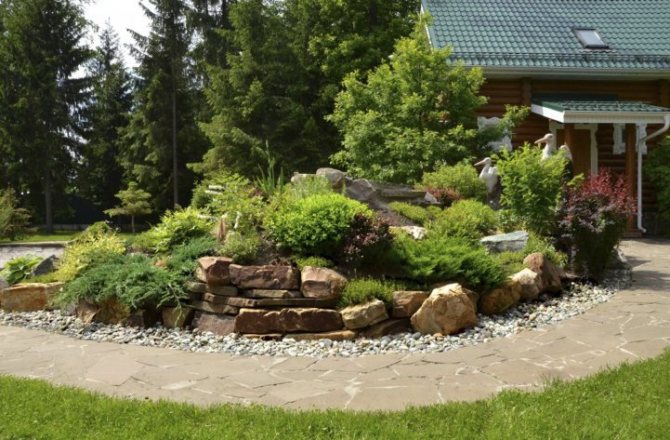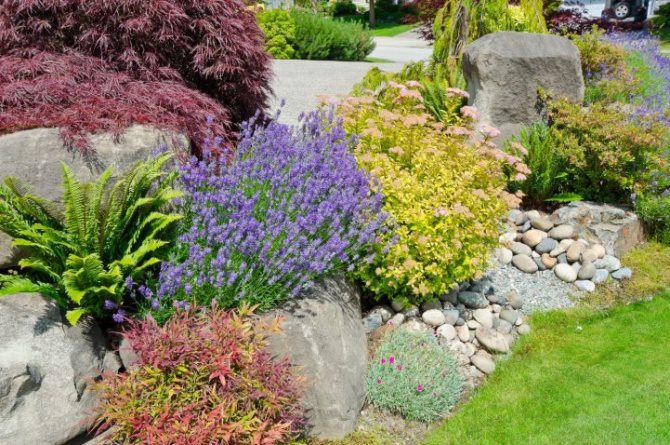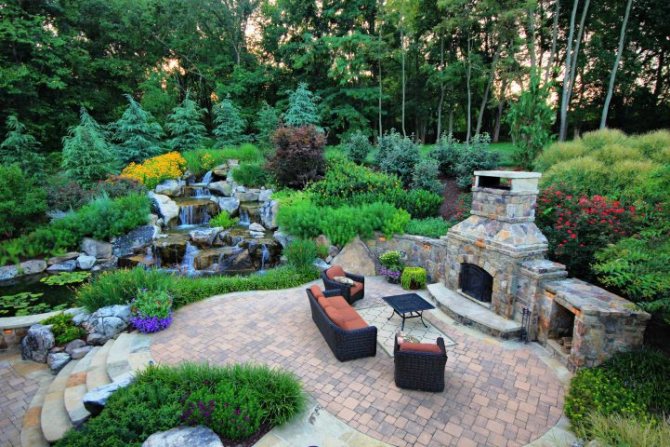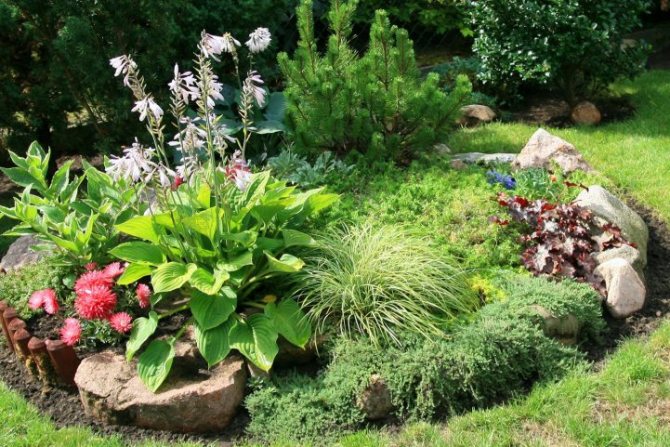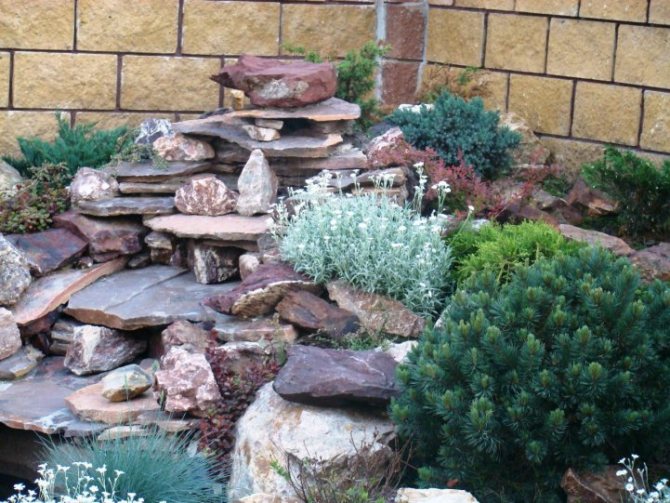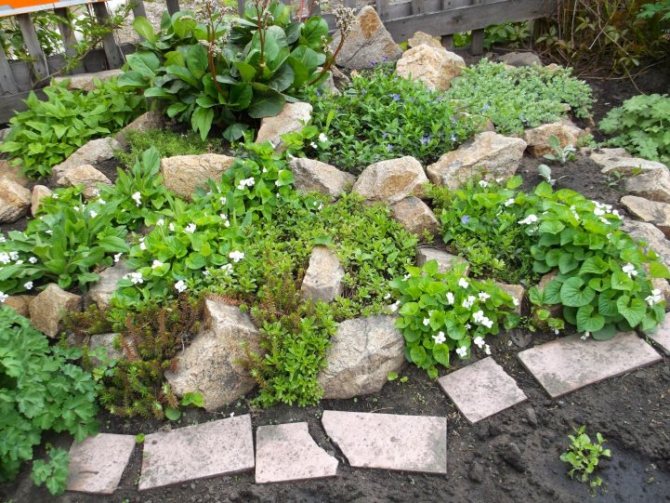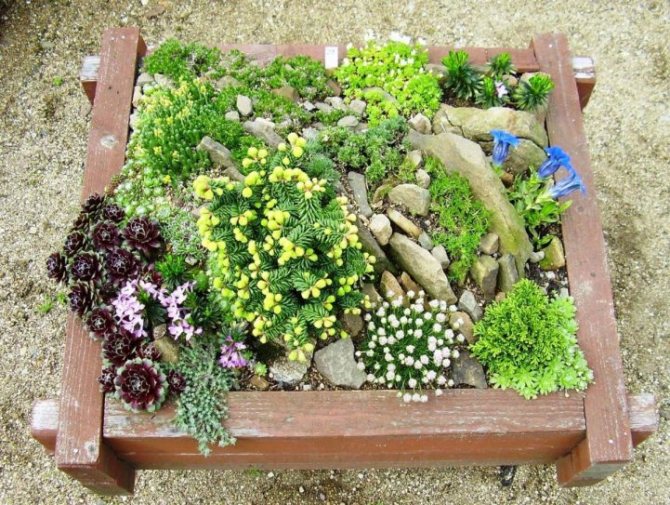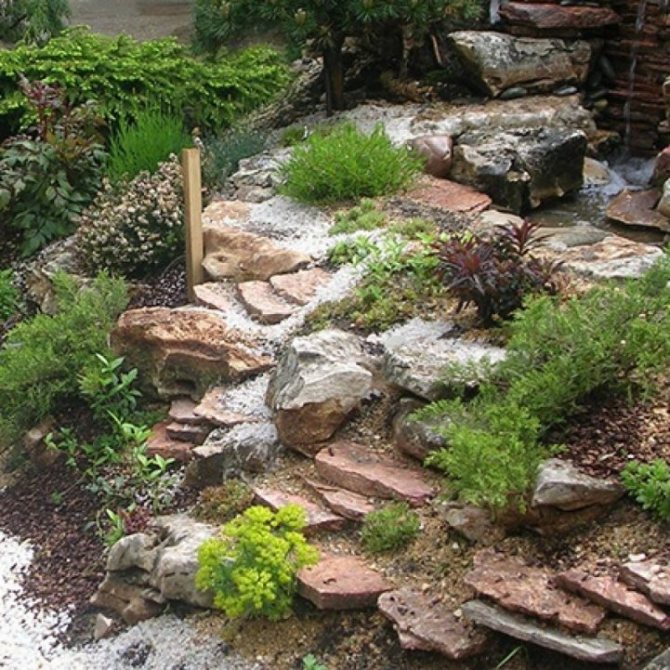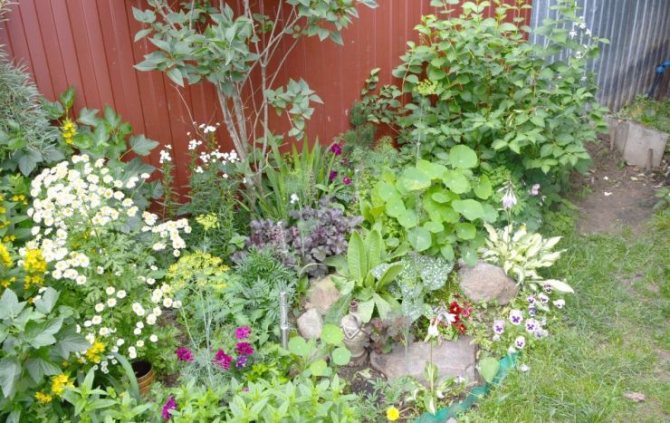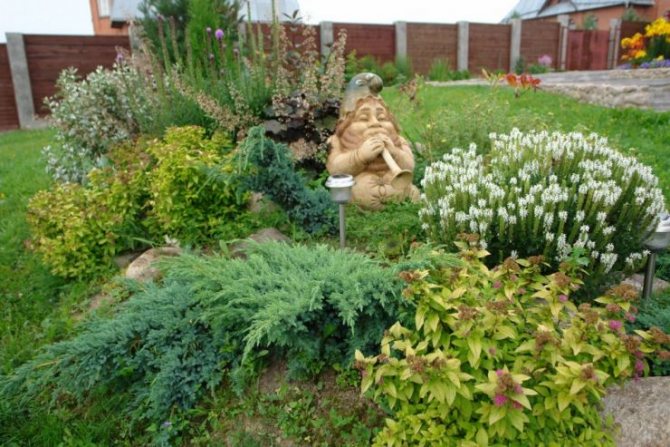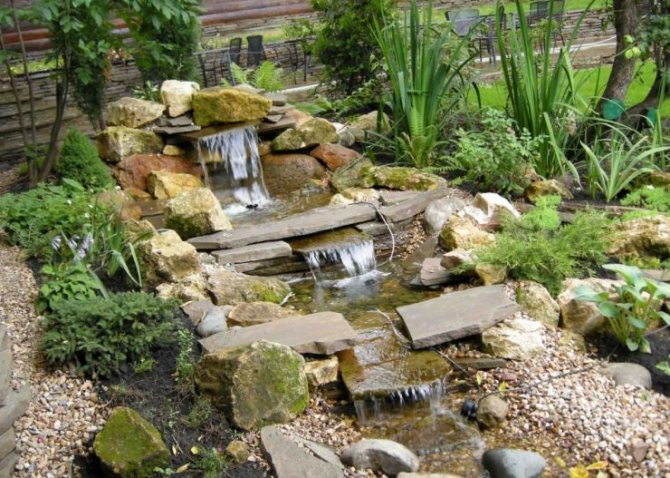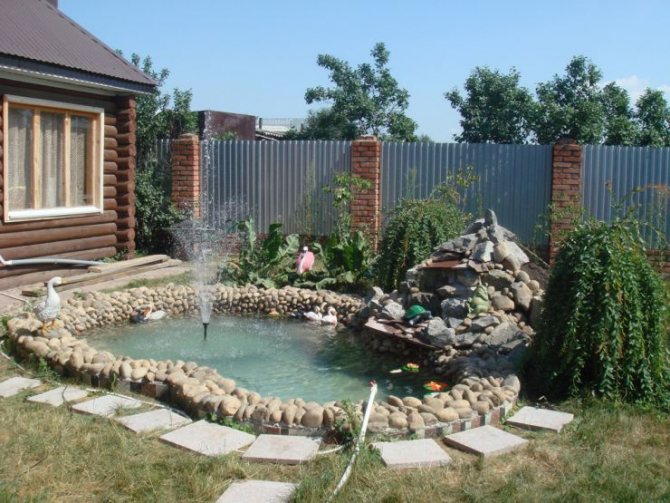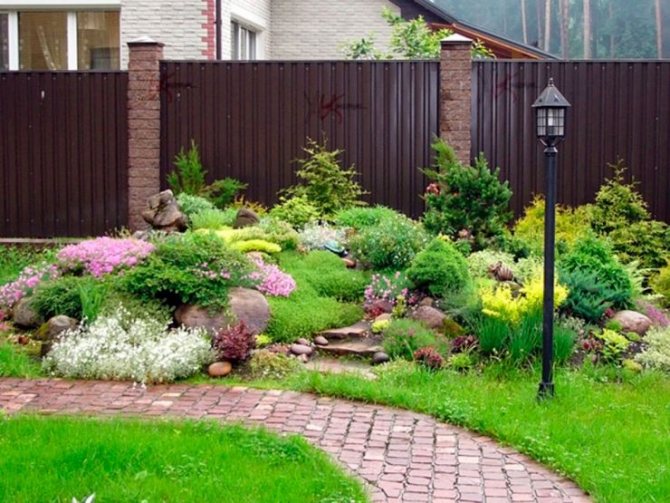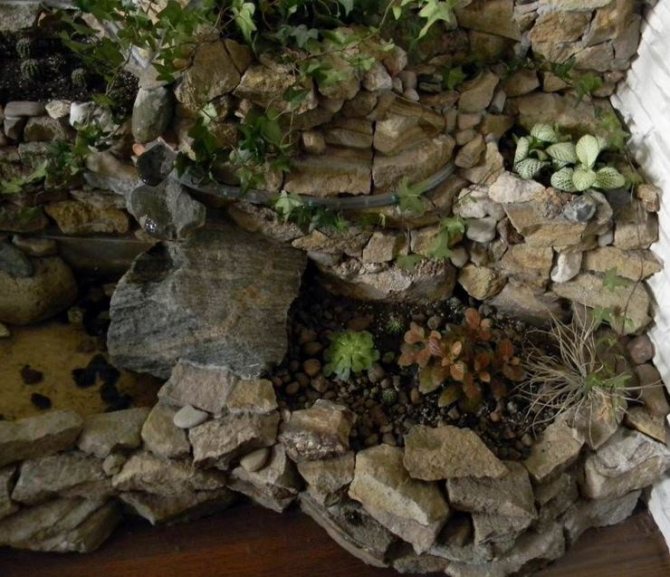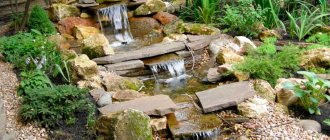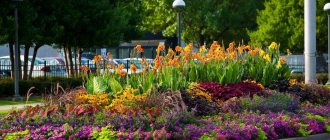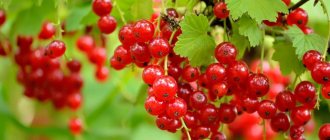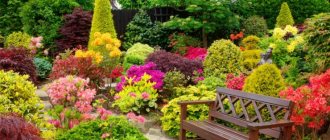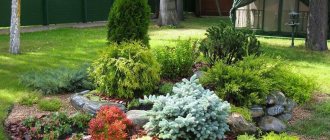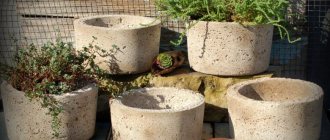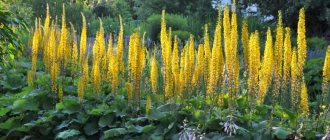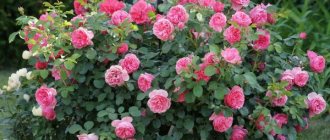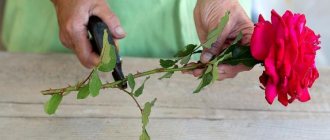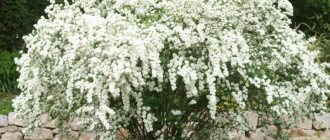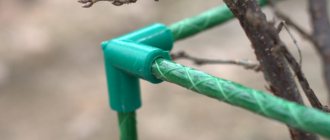- DIY alpine slide
- Choosing a place for an alpine slide
- What time of year can you equip a rock garden
- Basic rules for arranging a rock garden
- DIY alpine slide: step-by-step instructions with photo illustrations
- Drainage and soil for an alpine slide
- Choosing stones for an alpine slide
- What plants are needed for an alpine slide: the nuances of choosing colors
- Plants placement schemes on an alpine slide
- Landscaping of an alpine slide with conifers
- Herbaceous plants for an alpine slide: photo with names and a short description
- Periwinkle
- Saxifrage
- Turfy pike
- Soldanella
- Asparagus
- Sunflower
- Grouse
- Pushkinia
- Physalisoid bladder
- Poultry
- Lumbago
- Plantain
- Gray fescue
- Alpine edelweiss
- Likhnis
- Linen
- Bloodroot
- Primroses
- Iberis
- Kupena
- Sedum (sedum)
- Rock alyssum
- Rejuvenated
- Alpine slide in the country: photo examples of finished compositions
- Video: how to make an alpine slide with your own hands
DIY alpine slide
In an effort to transform the garden and create an original landscape - look for a unique and memorable landscape design element - alpine slide... Inheriting the landscape of real rocky mountains, the rock garden cannot be deprived of such a natural natural decoration as mountain flora. Properly selected plants will help to create the most natural look. photos with design recommendations will help create a real mountainous corner on the site.
Rockery with stones: instructions for creating a stone slide (read more)
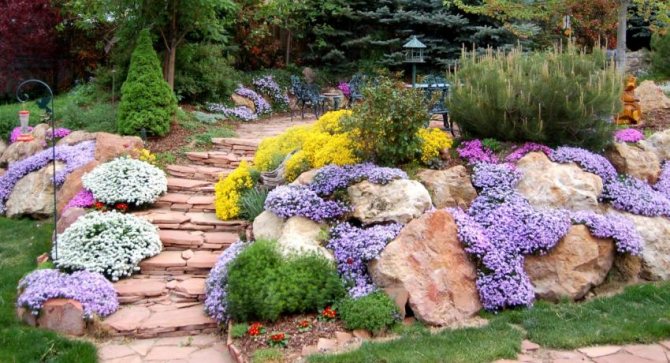
A rock garden is a beautiful landscape composition of stones and flowers.
A step-by-step photo instruction with design recommendations, and the name of plants for an alpine slide, will help you understand some of the intricacies of landscape business and create an original and very beautiful corner in a summer cottage or against the background of the facade of a country house.
Stone, flowers and water
The basic principle of the rock garden is the arrangement of flowers and stones: the largest pebbles are located at the top, creeping species of flowers and small stones live at the foot.
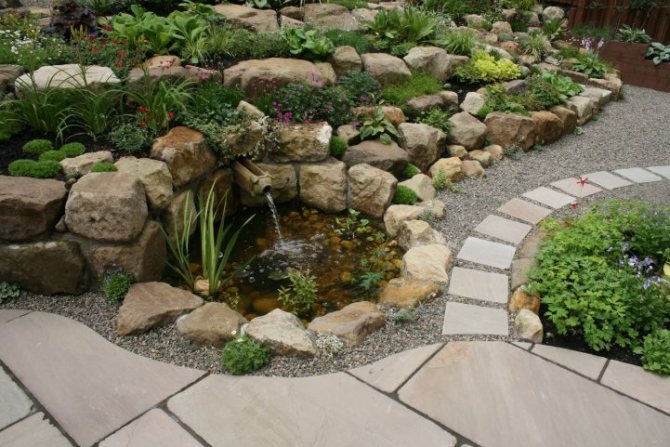

The slide always (except for winter, of course) looks original and compact. Artificial terraces can accommodate seasonal flowers.
And the rock garden also surprises the owners as an unusual landscape find: it is created not only in the form of a flower bed, but also on a terrace, porch or in a flowerpot.
We recommend reading:
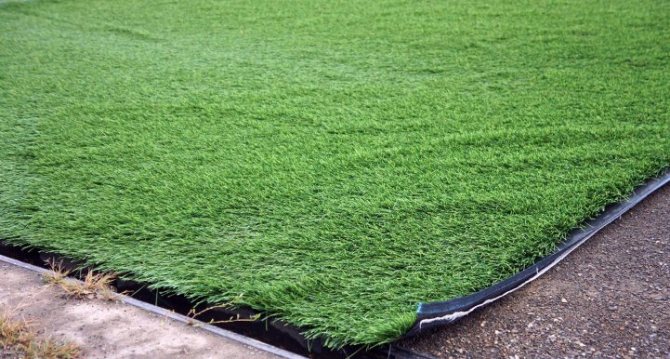

Laying an artificial turf with your own hands: how to choose and a step-by-step description of how to lay a lawn (100 photos)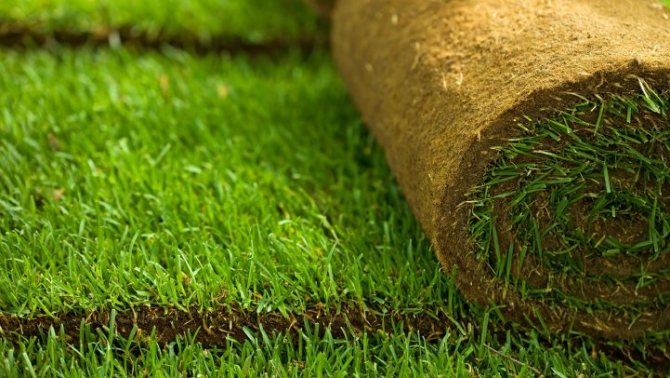

How to lay a roll lawn - a step-by-step master class and tips on how to lay a roll lawn correctly (120 photos + video)
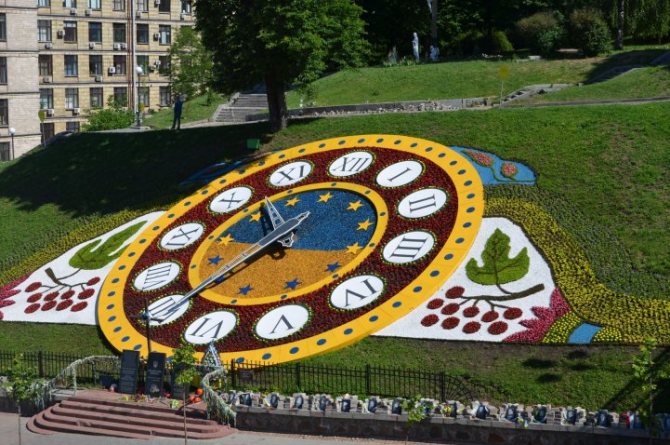

The best flower clock - a step-by-step description of how to make a beautiful element of landscape design correctly
If space, time and technical means permit, the owners create a slide and a pond in the complex. Sometimes even with a waterfall. This will require certain tools, an old bathtub or other container, and special instructions from the Internet.
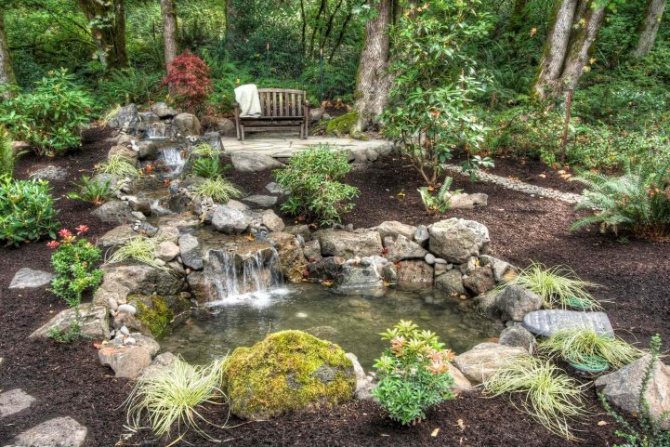

We will not dwell here in detail, our task is to tell you how to make an alpine slide in the easiest way.
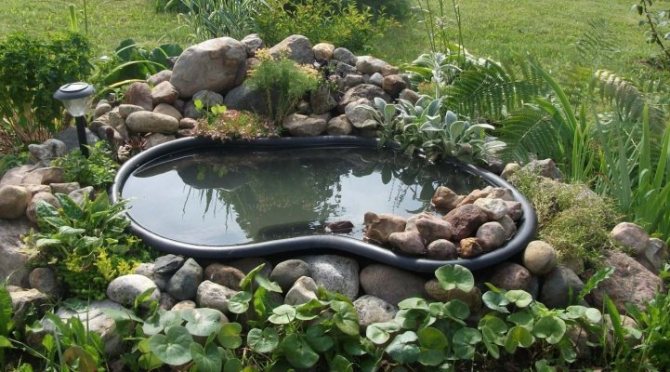

To start arranging a rock garden, the summer resident needs to decide which option he would like to see on his site:
- an alpine slide in a flowerpot is an original solution for a summer residence with a small piece of land. The mobile structure can be easily moved to the house for wintering;
- a typical rock garden is located in terraces in an open space;
- the third option is the most time consuming, but also the most effective: a rocky flower bed with a pond, waterfall or fountain.
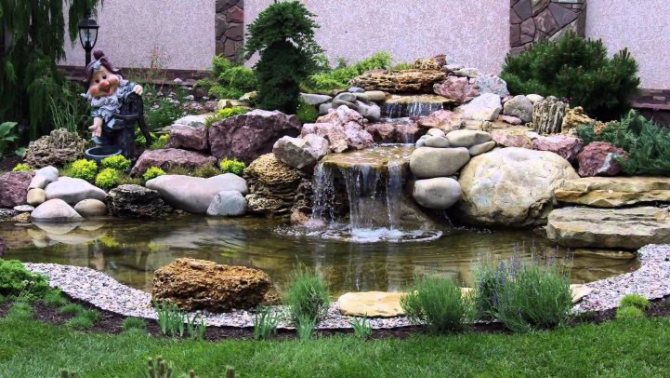

Choosing a place for an alpine slide
A rock garden or alpine slide is a small piece of wildlife located in a garden or plot. For such a masterpiece, you need to choose a place that is viewed from all sides. For a developed rock garden, sunlight is needed, so for it you need to allocate a part of the garden, located away from existing buildings and large trees with a developed crown.
It is better to equip an alpine slide on the southern side of the site.
It is good if the slide is located on the south side, not far from the recreation area. This arrangement will allow you to get optimal lighting, and you will be able to admire the beauty of wild plants and rocky stones much more often. Also, when choosing a place for a decorative flower bed, you need to pay attention to the quality of the soil. It is much easier to equip a rock garden on sandstones, but if the soil is clayey, then additional work will be required to create drainage.
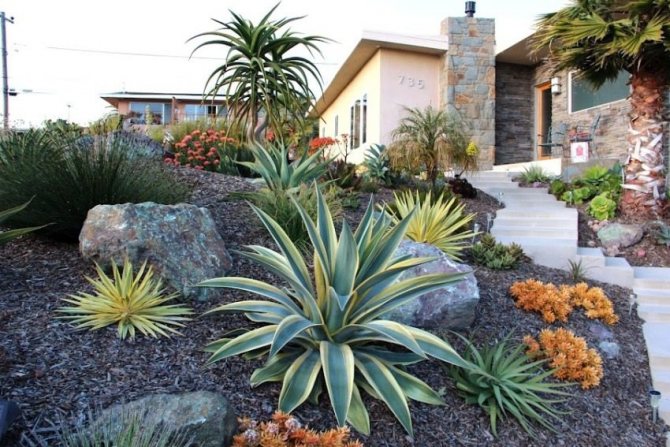

The rock garden is located on the slope of the site.
"Mountain Valley"
Another variety is the mountain valley rock garden. Its peculiarity lies in the fact that in fact it is not even a slide, for the most part it is located horizontally on the surface. In this case, stones of different sizes can be randomly located on the terrain, protruding in some places a little stronger or less so that the composition resembles a large valley with many mountains. It is also one of the easiest types of alpine slide to construct.
What time of year can you equip a rock garden
When arranging an alpine slide, the scope of work is such that it practically does not depend on the season. But it is not worth doing this in winter due to weather conditions. But the best option is still considered early autumn, when amateur gardeners have free time between harvesting and harvesting the site for the winter.
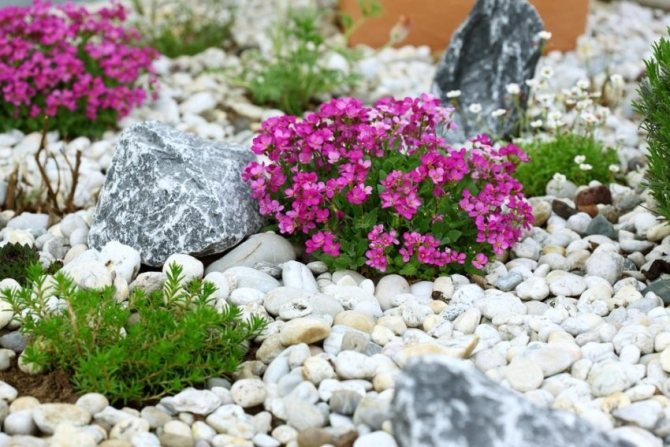

Alpine slide using small and large stones.
It is worth knowing that the rock garden takes several months to shrink naturally. After that, all previously invisible errors will be visible. Before planting plants, these disadvantages should be eliminated. If the planting of flora representatives is planned for the fall, preparations begin in the spring. There are several basic rules for creating an alpine slide with your own hands. A step-by-step photo gallery demonstrates the intricacies of this process.
The rock garden is a decoration of the suburban area.
"Rock"
The first option is an alpine rock slide. This is perhaps the easiest construction to create.
It consists in the arrangement of the largest stones at the base of the hill, around which there are smaller stones, and the smallest ones are closer to the top. This type of alpine slide is suitable for most gardens, and it is also not as difficult to recreate it on your site as some other types.
Basic rules for arranging a rock garden
Before planting flowers, it is necessary to prepare an appropriate quality base. When creating a rock garden, adhere to the following steps:
- estimate the size of the site and match your desires with the possibilities. Most plants for an alpine slide love light, so it is advisable to choose a well-lit place, perhaps with a little shading. Areas with relief differences are perfect;
- take care of quality drainage. Mountain plants generally do not like stagnant water, but prefer dry soil;
- select stones and determine the general appearance of the composition. If you have any problems with this, use the ready-made photos of the landscape design of the alpine slide with your own hands. Do not forget about the peculiarities of certain types of stones to leach and oxidize the soil. This knowledge will be useful for the correct selection of plants and protect them from death;
- fill up the soil between the stones. Plants for rock gardens are most often unpretentious, but some like fertilized soil;
- let the whole composition settle for several weeks, or better - the winter period. After that, start the process of settling it with representatives of the flora.
Landscaping masters have developed plans and schemes, according to which the arrangement of the rock garden takes place. They take into account all the subtleties and nuances that help determine the location of the flower bed and the order of planting.
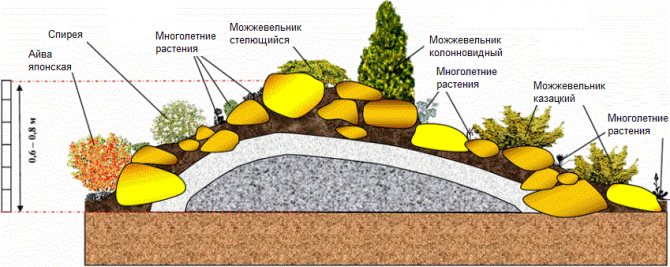

The scheme of planting plants on an alpine hill.
Provided that the alpine slide can be viewed from any side, the pyramidal shape, which has the highest point in the center, is best suited. Maintaining symmetry when arranging a piece of wildlife is not worth it. Composition will look more original if all elements are located abstractly. If the location of the rock garden is planned on an existing slope, then parts of the structure can be placed at the same level.
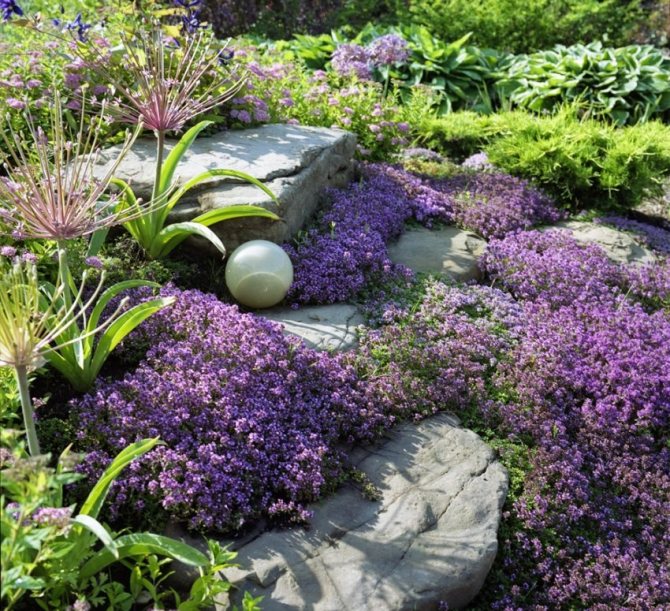

Rock garden with bright colors.
The height of the rock garden should correspond to its area. For each meter of the diameter of the future club, it is necessary to provide for a rise of about 0.2 m, respectively, an alpine slide with a diameter of about 4 meters should be at least 80 cm in height. Do-it-yourself step-by-step photos of alpine slides are presented below.
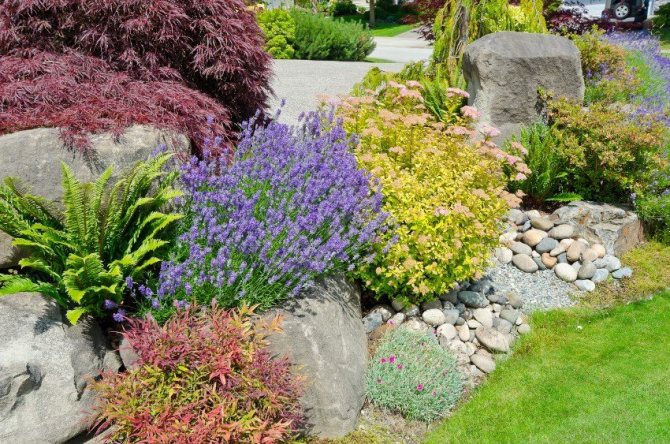

When arranging the alpine slide, large stones were used.
"Rocky Garden"
Another type of alpine slide is the "rocky garden". Such a structure can often be seen in parks or terraces, since such a slide does not require a surface with elevation differences. Therefore, if your site has an empty space with a perfectly flat surface, this option is perfect. A distinctive feature of the "rocky garden" is the use of large stones and boulders, while small stones are practically absent.
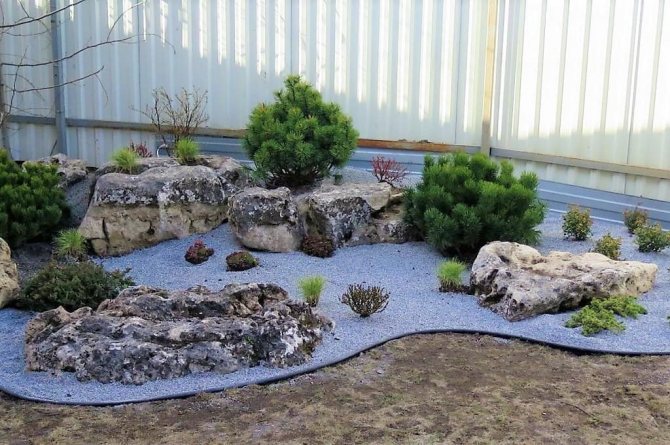

In such rock gardens, boulders stand alone or are successfully combined in 2-5 pieces. Also, relatively tall plants dominate here, flowers are rarely planted. Among the boulders are perennial dwarf trees. Also, if there are small bushes on your site, there is a place to place stones among them, then you will get an excellent "garden".
DIY alpine slide: step-by-step instructions with photo illustrations
Usually, amateur gardeners ignore the preparatory stage, equipping alpine slides in the country with their own hands. Photos of such not very successful compositions are presented in large numbers on specialized sites. Rock gardens, which are a common pile of stones, with plants planted between them, rather quickly lose their appearance and shape. Therefore, before arranging such a masterpiece, you need to carefully read the stages of work.
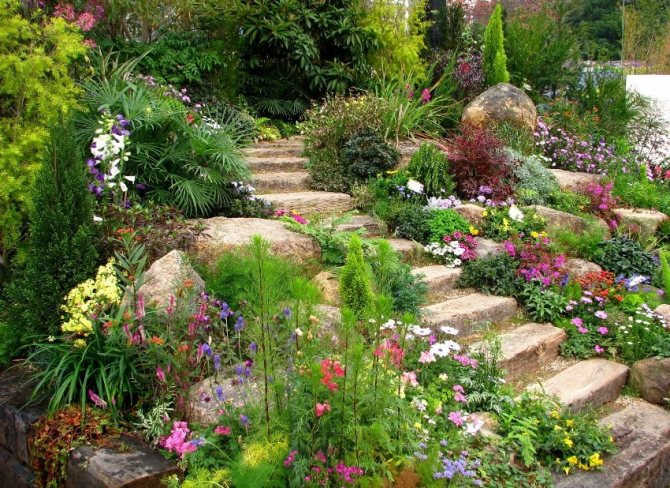

Rock garden on both sides of the garden steps.
"Mountain slope"
Another type is called "mountain slope". This alpine slide has only one slope, usually located on a hill or fits into the outer corner of the building.
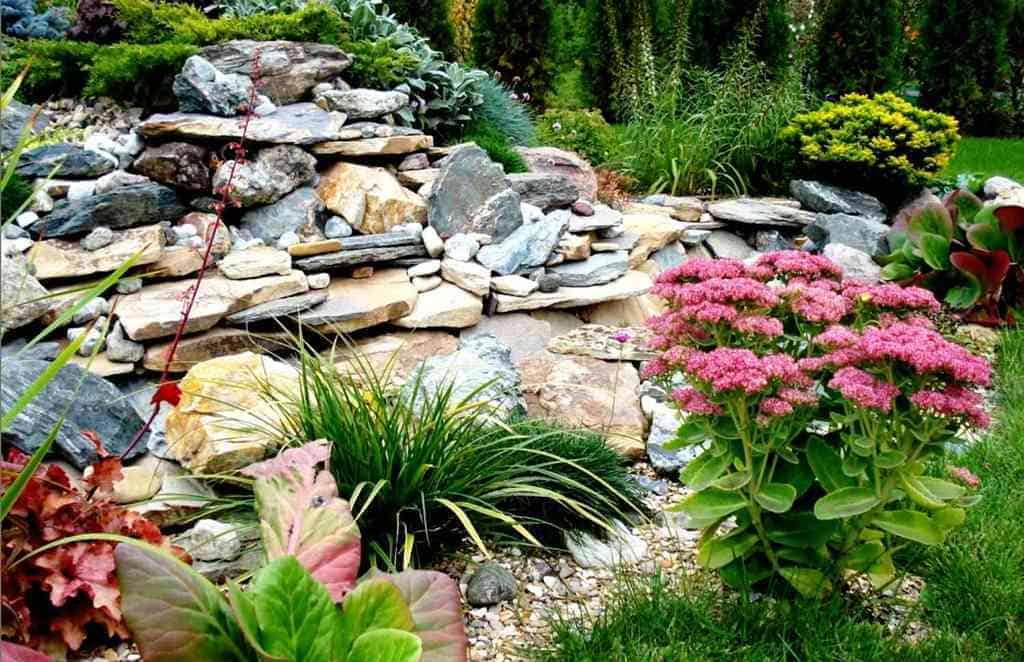

The stones here are located equally opposite to the previous version: the largest of them are closer to the top, and the smaller ones are scattered at the foot. In this case, setting the stones can be a little more difficult.
Drainage and soil for an alpine slide
Since the earth under the pressure of the heavy stones used to create the alpine slide settles, a drainage base should be provided for the entire structure.It is also necessary for expensive plants, as it allows you to create an optimal microclimate for their development.
On a note! It is recommended to thoroughly spill each layer of drainage and soil laid with water, as well as to carry out the final watering after planting all the plants.
The following are often used as drainage:
- broken red or white brick;
- fine gravel;
- small stones;
- crushed stone;
- construction waste of non-wood origin.
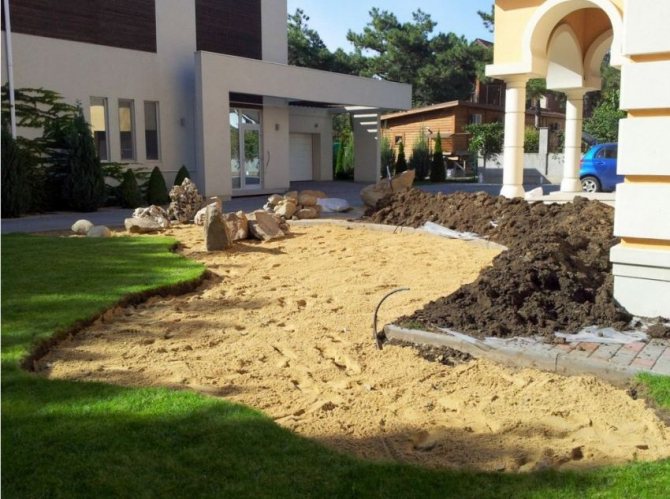

Site selection and drainage device for the future alpine slide.
For its laying, a pit is dug. The depth of the pit will be approximately 1 meter with a total area of the alpine garden of 8-9 m². This is about 3-4 bayonets of an ordinary shovel. The drainage is laid in the pit and spilled well with water, after which it is covered with earth.
An example of a good soil is a mixture of ordinary, free from weeds and debris, soil with peat and ordinary river sand in equal quantities. In general, there are no special requirements for the composition of the base, because most often unpretentious plants are used for the rock garden.
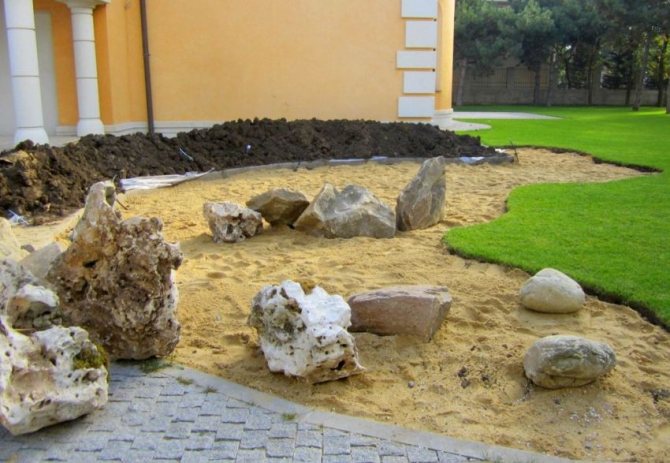

Placement of stones on an alpine slide.
On a note! More information about the features of creating a drainage for an alpine slide with your own hands, step-by-step photo schemes for laying stones and backfilling can be found on thematic Internet resources.
"Wall"
Also, the so-called "wall" belongs to the more modern varieties of the alpine slide.
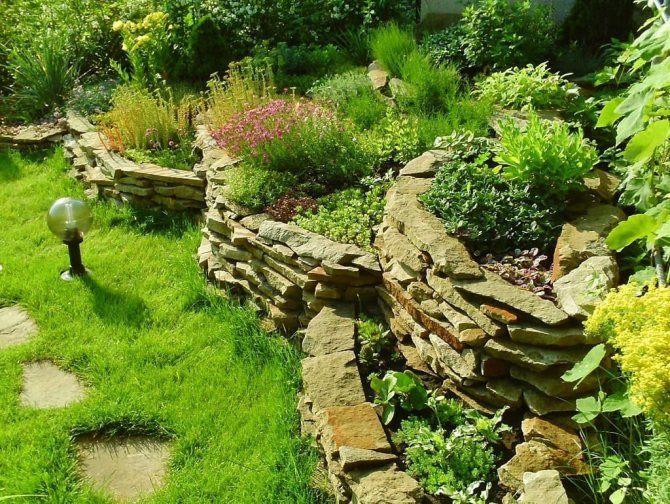

The design plan in this case is extremely simple and consists of stones of a flatter shape, lined with a low wall of each other. When erecting such a rock garden, it is important that the wall independently maintains balance, so you should carefully consider its fastening. Such curbs can be arranged in several rows or form different shapes. Warm light tones of stone are more suitable for such a design.
Choosing stones for an alpine slide
There are many varieties of stones that will look great in your garden. These include:
- granite;
- wild stone;
- limestone;
- tuff;
- sandstone and others.
Planting of perennial plants.
Observing the following simple rules, it is easy to create an alpine slide with your own hands. Step-by-step photo placement of stones will help you choose the optimal design for any area. So:
- the selected stones should not be the same size;
- it is preferable to select specimens uneven in shape and structure;
- the finished flower bed should be asymmetrical to the maximum;
- the selected stones must be of the same type.
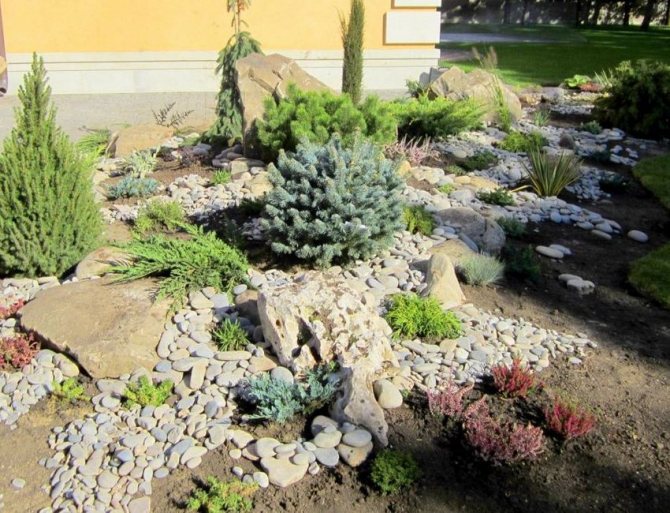

Planting conifers.
You can arrange stone elements in different ways, it all depends on the owner's imagination. Professional designers offer several schemes for laying boulders. Large stone blocks located throughout the entire area of the rock garden, with smaller fragments scattered between them, look quite original.
Someone will prefer to place the most beautiful and interesting boulder at the very top of the slide, while someone, on the contrary, will lay large specimens closer to the bottom. Any options are eligible for implementation.
When creating a rock garden from a massive stone, try to seek help from family and friends. It is quite difficult for one to master such a structure with his own hands. A photo of alpine slides with stones demonstrates the scale of these compositions.
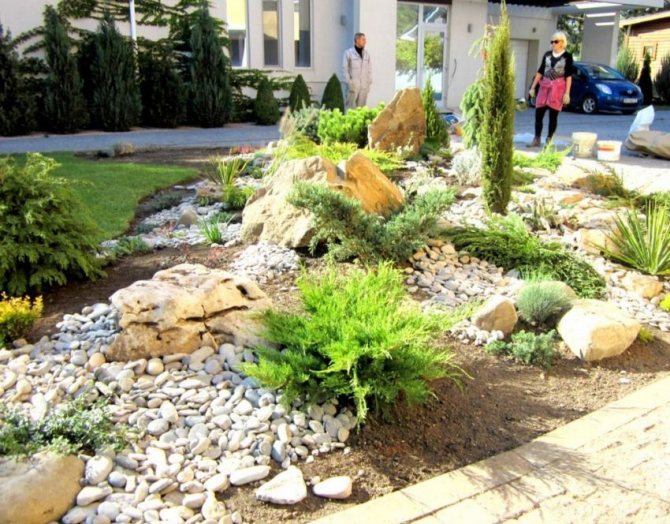

Backfilling of small stones, the final formation of the composition.
When installing large and medium stones, you should take care of their stability. In places invisible to the eye, they can be fixed with cement mortar to give the whole structure greater strength. Slightly dug boulders look good. This move allows you to simulate the rupture of the ground by rocky rocks and strengthen the entire rock garden.
On a note! An alpine meadow looks good on a garden plot. It is a bright green meadow covered with meadow flowers.For its device, stones are usually not used, but the effect of a slide is created by arranging the plants in height.
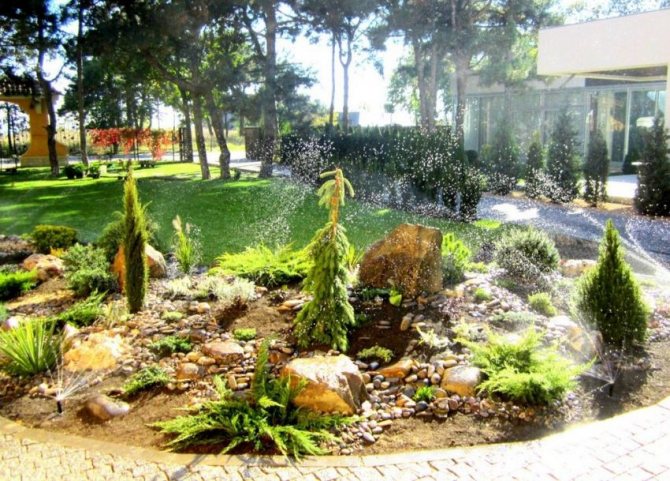

Watering the finished rock garden.
After arranging the base, after a couple of months, you can start planting plants. You can use any types of plants that do not require particularly careful care, tolerate bright sun and heavy rainfall.
On a note! In order for a rock garden to delight with beauty all year round, you need to know the timing of flowering of various plants. Bulbous ones bloom in spring, in autumn mostly perennial specimens, and in winter the alpine hill is not allowed to be empty - conifers.
It is better to select slow-growing specimens for arranging an alpine slide in the country with your own hands. Photo-finished compositions show how original and beautiful, for example, coniferous evergreens on such unusual flower beds can look.
Looks good:
- thuja;
- some types of firs;
- juniper;
- mountain pine.
Such plants can be given any intricate shape. With their original appearance, they ideally complement an alpine flower garden. Gardeners give such representatives of the fauna a conical shape or cut them in the form of other interesting figures when creating an alpine slide with their own hands. Step-by-step photos showing the correct cropping options will help you cope with this task on your own, without inviting a landscape master.
Of herbaceous plants, the following are suitable:
- periwinkle;
- undersized carnation;
- thyme;
- nasturtium;
- marigold;
- bell and many others.
"Czech rock"
Next, we will consider a very interesting and original type of alpine slide called "Czech rock". As you might guess, this variety imitates a high rock or cliff. The peculiarity is that long, narrow stones are used here, which are placed directly on the edge.
You can create one rock, or many of them, by placing stones at a short distance from each other. Dwarf plants sit in the "crevices". This is one of the most beautiful and mesmerizing views of the alpine slide that everyone will definitely enjoy. Also here you need to think carefully about the fastening of the stones, for example, placing them about half in the ground.
What plants are needed for an alpine slide: the nuances of choosing colors
When choosing plants for planting in rock gardens, you must be guided by both the climatic requirements for individual species and your own preferences. It is advisable to choose low-growing, slow-growing crops. This also applies to trees with shrubs.
Tall plants can shade areas, interfering with the growth of light-loving representatives. But they are perfect for creating bright accents. Ground cover plants will cover the surface and create a general background.
On a note! You should not plant a lot of rapidly growing ground cover plants, because they can drown out other species and spoil the overall appearance of the composition.
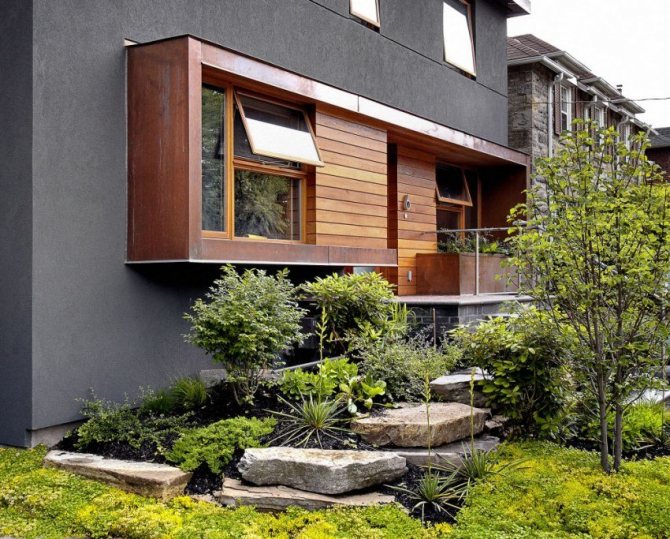

Low-growing trees, shrubs and flowers are suitable for an alpine slide.
Perennial plants will be most suitable for alpine slides. The periods and duration of their flowering must be taken into account. Having planted plants with alternate flowering, you can count on the fact that the decorative appearance of the slide will be observed from spring to late autumn.
So that immediately after winter the alpine slide takes on a blooming appearance, the top is populated with annual early flowering plants. And in winter, conifers and shrubs will give liveliness to the composition. On an alpine slide, you can grow not only decorative, but also medicinal plants. Thyme, chamomile, sage will fit into the overall composition and bring health benefits.
Some plants grow well only in sunlight, so it is necessary to determine a place for them on the south side of the hill. Others prefer shade, the north side of the rock garden will suit them.Therefore, before planting, study the conditions for growing species according to the photo and names of flowers for the alpine slide.
The reliefs and slopes of the site can be used to create an original landscape.
Thus, adhering to the above recommendations, the creation of an alpine slide will turn into a real creative process, and the result will delight you for more than one year.
Suitable plants
Great for stone gardens - evergreen and hardy as well as annuals. Even perennials like shamrocks or soft phloxes, conifers and shrubs like lavender and blue lavender blend well between stones. Alpine plants such as primroses and carnations provide a special mountain atmosphere.
back to menu ↑
See also: Landscaping your site with your own hands - (130+ Photo ideas & Videos) + Reviews
Perennial plants
- Gentian
- Edelweiss
- Stone rose
- Cyclamen
- Primroses
- Immortelle
- Bell
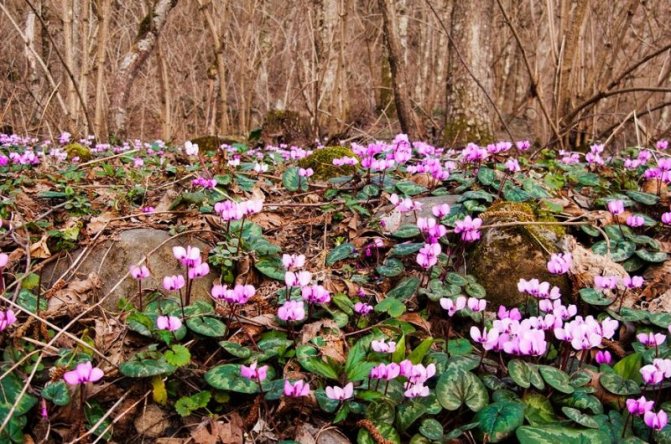

Cyclamen kosky
back to menu ↑
See also: Swimming pool in the country: device, step-by-step instructions for arranging yourself | 65+ Photos & Videos
Shrubs or trees
- Mountain dwarf pine
- Spruce
- Creeping juniper
- Little gorse
- Bells
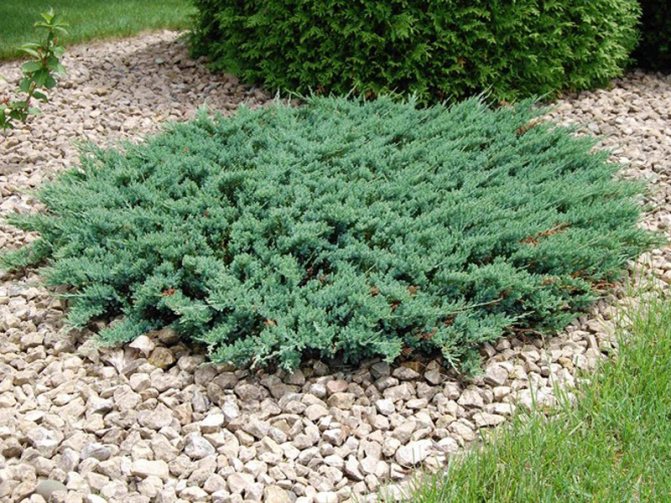

Juniper creeping
back to menu ↑
See also: Blueberries: a description of the 25 best varieties from early to late ripening. Secrets of agricultural technology and useful properties of berries + Reviews
Herbs
- Bluegrass
- Sitnik
- Xerophyllum durable
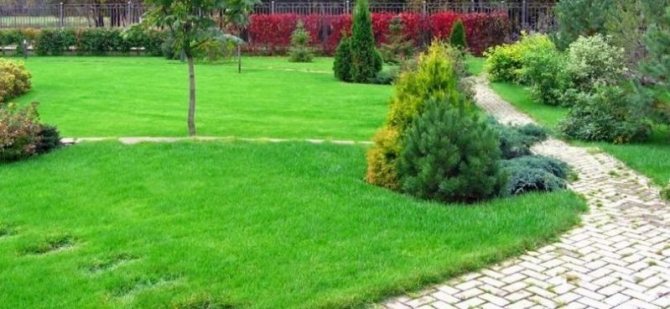

Meadow bluegrass lawn
back to menu ↑
See also: We equip a pond in the country with our own hands: interesting landscape ideas, useful information on creation, decoration, care | 75 Photos & Videos
Bulbous and tuberous plants
- Wild tulips
- Crocuses
- Low daffodils
- Squill
- Grape hyacinth
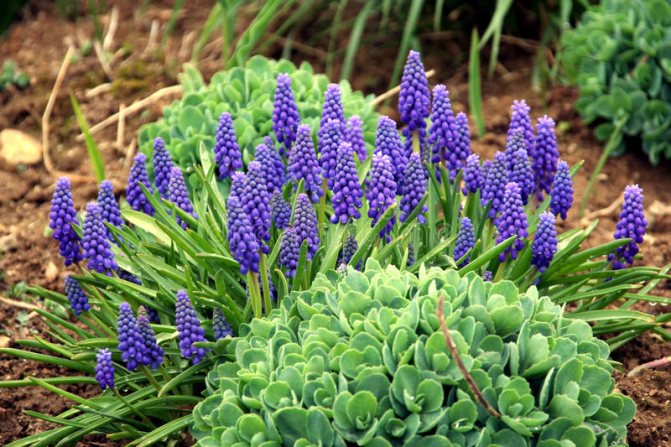

Grape hyacinth
After you have decided on the plants, you must first place the pots on the surface of the slide for preliminary assessment and "trying on".
Make sure the plants are in harmony in height and color and respect the lateral tendency of the plants to spread at intervals. Then, use a hand shovel to dig the bore hole at the indicated location. Place the plant only 2/3 of its height in the hole and, if desired, place a nameplate next to it.
Fill the root area with soil and press down a little. After you have planted all the plants, pour a generous amount of water over the pile.
Plants placement schemes on an alpine slide
At first glance, it is quite difficult to create the most organic composition. You can resort to the help of specialists in landscape design. Or you can study a photo of alpine slides with your own hands for beginners, be patient, analyze information and various planting schemes in different sources and create your own unique masterpiece. In order for the slide to look harmonious and some plants do not interfere with the growth of others, they are planted in tiers.
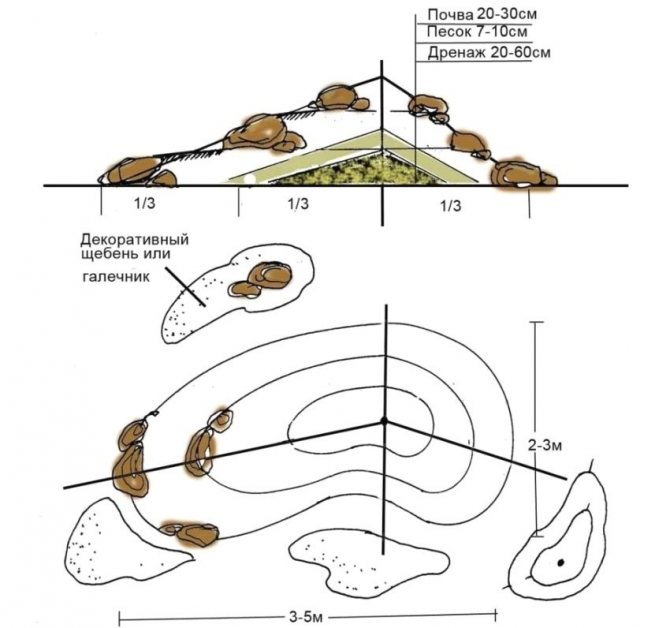

The scheme for creating an alpine slide.
For each tier, certain types are selected:
- the foot of the hill is populated with those species that love moisture and fertilizer-rich soil. At the foot of the rock garden there is usually high humidity and not always adequate lighting. Therefore, here you can give preference to ornamental grasses (for example, turfy pike), as well as to the regulars of the alpine hills, rejuvenating and saxifrage;
- the middle tier is occupied by less whimsical representatives of the flora. Since there will be less light on the middle tier, plants with the ability to tolerate shade are selected. Phlox, lumbago, primroses, etc. will be appropriate. And varieties of ground cover sedum will help fill the voids between upright flowers;
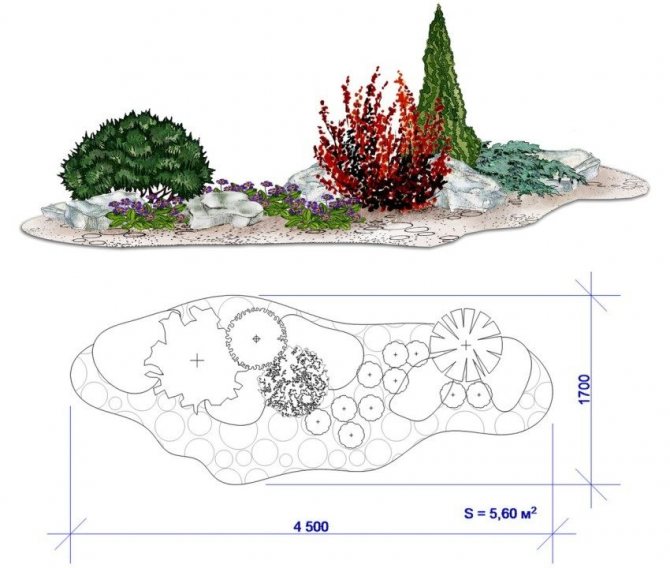

Rockery scheme with barberry and pine.
- early flowering perennials, annuals and bulbs, requiring warm sunlight and dry soil, are located on the tops.The top of the alpine hill will look picturesque with Iberis, which will cover it with a blooming white veil. Lilac dyes can be added with creeping thyme. Yellow varieties of rock alyssum will dilute the lilac-white range. The light-loving mysterious edelweiss can rightfully be called the king of the summit.
Trees and tall herbaceous plants are planted first. Usually their place is at the base of the slide or in the background. They will look organic near large boulders. Low-growing perennials are planted all over the hill. The tiers are visually separated using stones or plants higher.
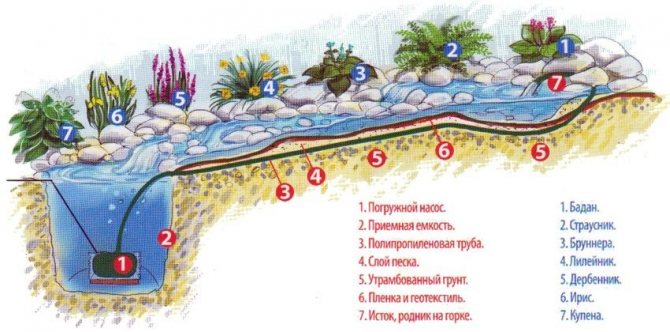

The project of arranging a rock garden with a reservoir.
While slow-growing perennial flowers are growing, the area can be temporarily decorated with annual plants with reduced self-seeding. It can be purslane, marigold and other low-growing plants for landscape design, photos and names of which can be spied on gardening sites.
Building
As the basis of the slide, the largest boulders are laid out along its perimeter, and each cobblestone must be strengthened in the ground by more than half of its volume.
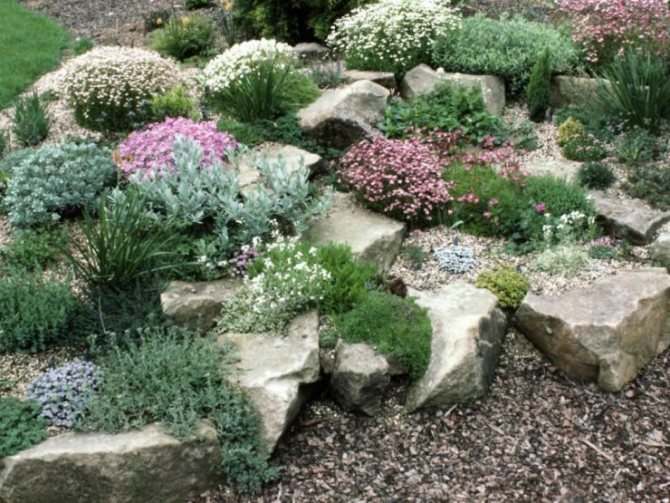

It is worth trying to position the defective stones so that their imperfections are not visible from the outside.
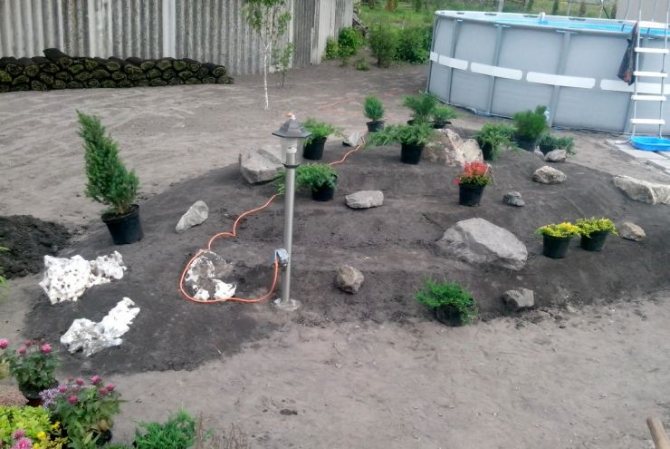

Experts do not recommend using artificial stone, since the structure itself should look natural, as if it was formed under the influence of natural factors.
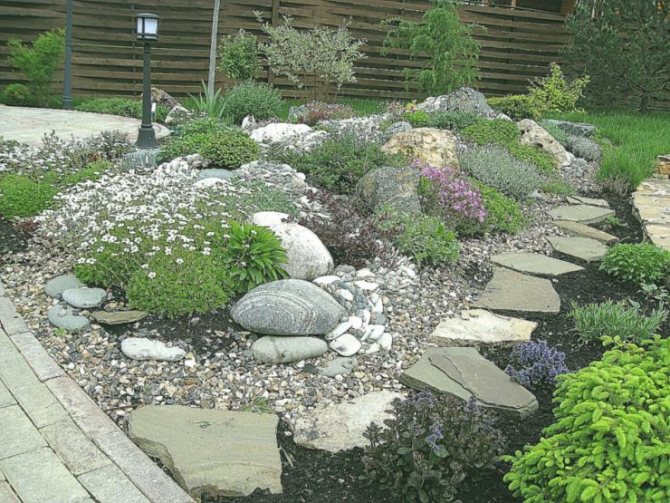

As for the selection of plants for the slide, it is recommended to use plants alternating with flowering stages with others located on the slide.
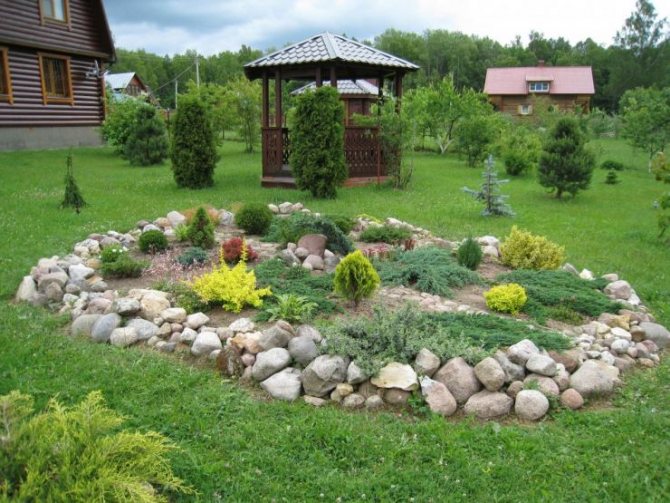

The parameter of the height of future trees and tall shrubs is also especially important, so that they do not interfere with the development of lower representatives of the flora by shading.
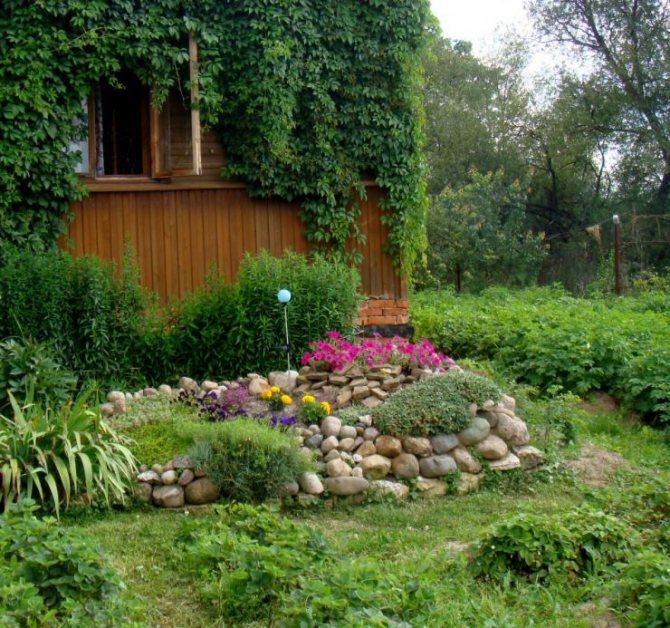

Landscaping of an alpine slide with conifers
Not a single mountain landscape is complete without dwarf coniferous shrubs. It can be creeping, cushion-shaped varieties of such conifers as:
- thuja western (Danica, Little Dorrit, Hoseri);
- mountain pine (Mughus, Gnom, Mors, Winter gold);
- Norway spruce (Little Gem, Nidiformis, Will's Zwerg, Echiniformis);
- spruce canadian or gray (Conica, Alberta Globe);
- junipers (Nana, Еchiniformis, Green Carpet, Tamariscifolia, Blue Carpet, Blue Star);
- fir (Korean).
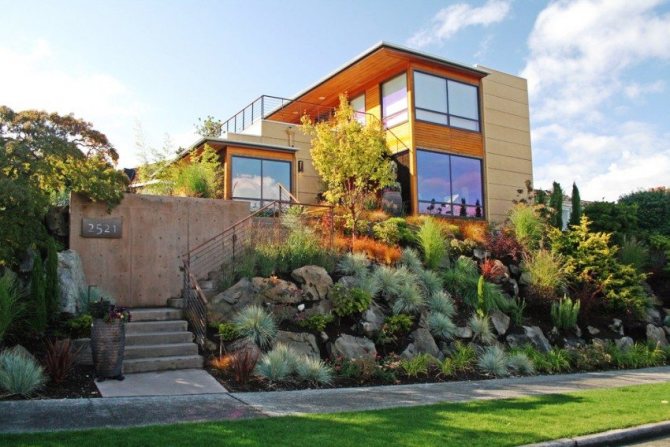

Dwarf coniferous shrubs diversify the flora of the alpine slide.
For small alpine slides created with your own hands, the height of the conifers should not exceed 0.5 - 0.7 m. If the site is large and the rock garden is extensive, then their height can reach one and a half meters. You can combine ephedra to create a contrast in color and shape. Another option is a smooth transition from one form to another. This creates a dynamic picture. The same technique can be applied to color dynamics.
Compliance with the recommendations for the correct selection of substrate for conifers and planting time ensures that these evergreen plants will decorate your corner of nature for a long time.
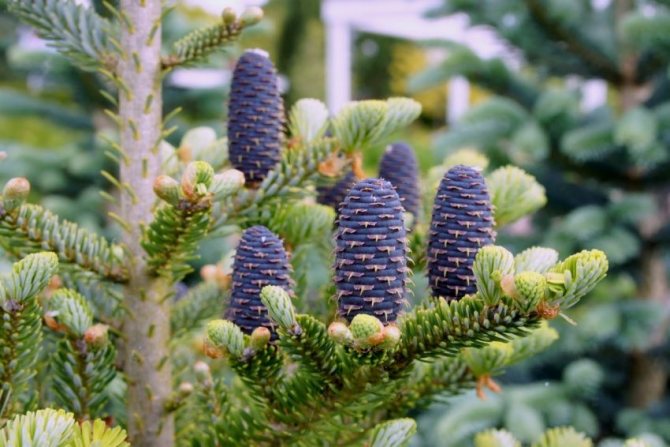

Korean fir looks spectacular on an alpine slide.
Rock garden stones - choose the right one
Usually, during the construction of the slide, natural stones of rocks are used: basalt, granite, sandstone, limestone, as well as rare rocks, characterized by low porosity and strength. It is undesirable to use tuff, shell rock and dolomite for the device. These rocks absorb water strongly, as they are porous, so the stones quickly collapse.
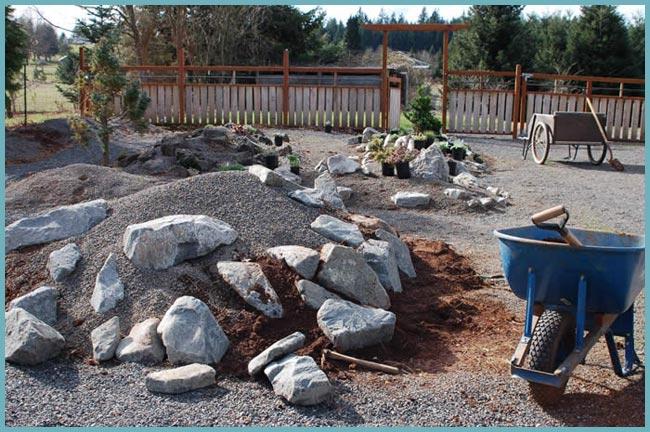

The stones for the alpine slide must be strong, of different sizes
The shape and color of the stones are of great importance. Avoid rounded stones as well as overly sharp-angled boulders. Stones of different colors look harmonious only on a certain type of alpine slides.The classic version of the slide arrangement involves the use of stones of the same breed, but of different shapes.
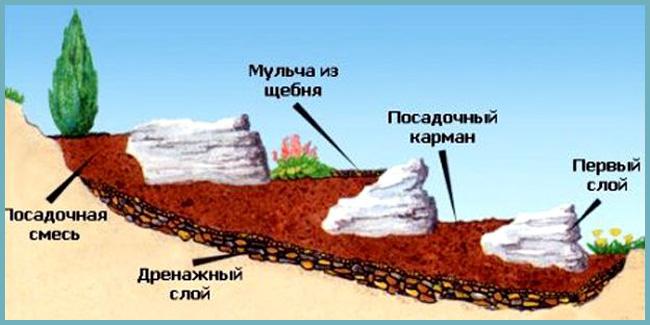

Scheme: deepening stones for an alpine slide
Place the stones on the slide in such a way that the edges in the viewing area have the most attractive shape. Defective stones should be masked by placing them in the most favorable way. Stones should be laid taking into account the size and weight, following the most harmonious appearance of the created slide. Stones should be placed randomly, the most natural, therefore it is better not to use stone blocks and artificial boulders, manufactured in an industrial way.
Herbaceous plants for an alpine slide: photo with names and a short description
Below we will consider which plants are most suitable for planting on alpine slides.
Periwinkle
As you can see in the photo, periwinkle blooms with blue flowers, which, together with juicy green leaves, create a dense cover. Periwinkle is unpretentious, feels great both in the sun and in the shade. It can be used to braid voids between tall plants. The flowering period is from late spring to autumn.
Periwinkle with pale purple flowers and dense leaves.
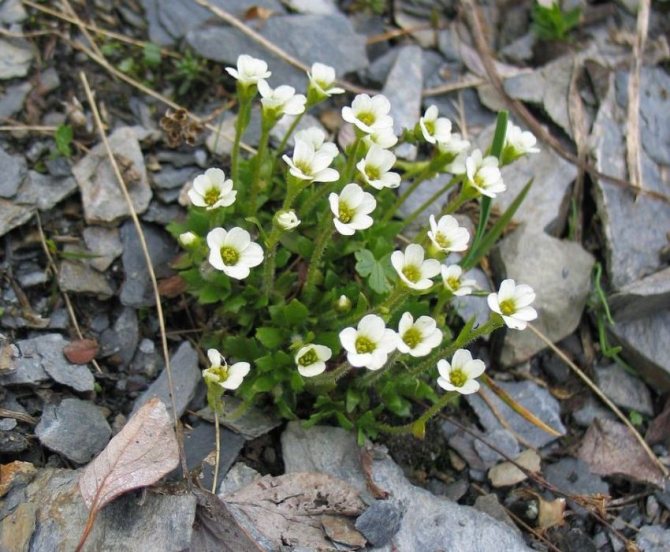

Saxifrage thrives in rocky and stony areas.
Saxifrage
This perennial plant is able to exist on any soil, even on stones. Therefore, it is used to decorate those places on alpine slides and rockeries where other flowers cannot survive. Small dense leaves grow into a carpet and are covered with colorful flowers. As the photos illustrate, saxifrage can be pink, red, white, golden, blue and yellow. The flowering period and color depends on the type of this ground cover plant, and there are about 370 of them in total.
Turfy pike
Another name for this decorative cereal is "meadow". The plant is in the form of a neat dense bump, has hard thick leaves and inflorescences of small spikelets in the form of a spreading panicle. It is a moisture-loving herb that loves sun, but not drought. There are many decorative varieties with different colors. It can be accentuated in the overall composition. It also looks great in bulk.
On a note! In the spring, it is better to cut off old leaves that have turned yellow during the winter to give room for new growth.
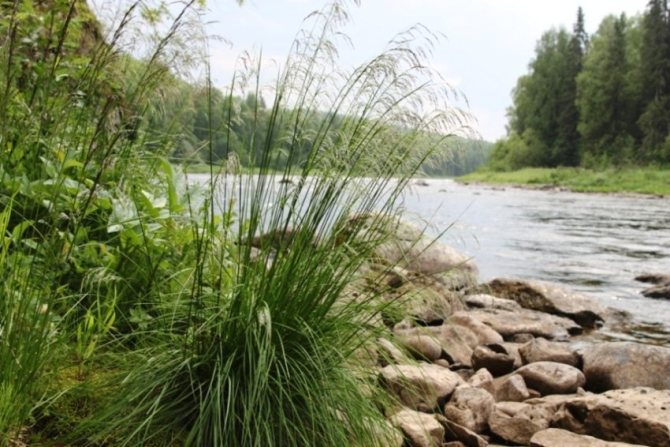

Sod pike (meadow) belongs to the family of cereals.
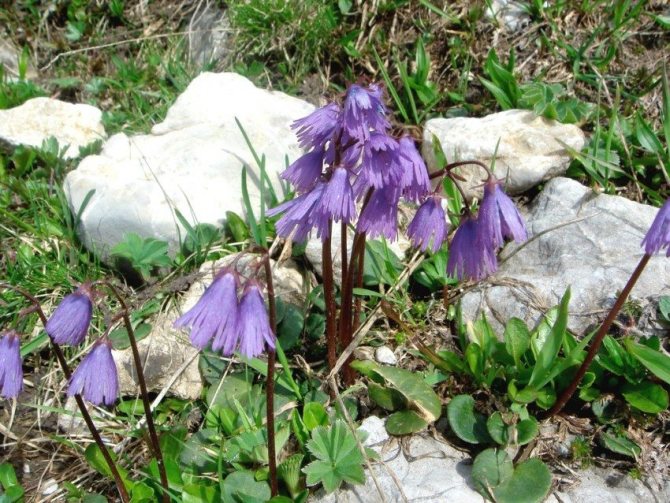

Snow bells (soldanella) grow in small bushes.
Soldanella
Translated from Spanish - small coins. A genus of mountain flowers, also known as "snow bells". They are small in size, white or blue, bell-shaped stalks and heart-shaped leaves. Soldanella is whimsical to care for, requires moist soil with good drainage. But the sight of this delicate flower will fill the rock garden with the freshness of the mountain peaks. It is planted in the spring by dividing the bush.
Asparagus
The genus Asparagus has about 300 species. This plant is better known to us under the name "asparagus". Heat-loving species have dense acicular greens of various shapes. The inflorescences of this plant have small white flowers, which turn into bright red berries in autumn. For decorating an alpine slide, whorled asparagus is more suitable. A photo of this species confirms that it produces very dense greens. Globular asparagus with more compact bushes will also work.
Various varieties of asparagus are suitable for landing on an alpine slide.
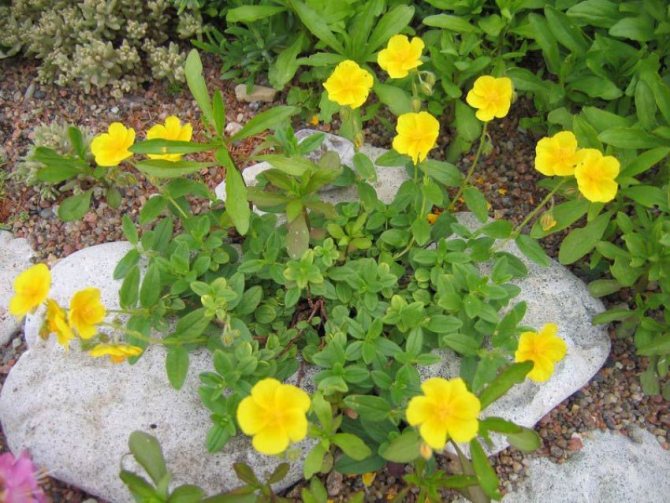

Sunflower with yellow flowers and creeping stems.
Sunflower
Low herbaceous plants growing as shrubs with creeping stems. It has gray-pubescent leaves and silky flowers of yellow, orange, pink or white color. For the sunflower, it is important to choose a well-heated, sunny place with good drainage. The soil should be alkaline, sandy or rocky. The plant is a young plant, it is planted by cuttings. The most used in decoration is the monotonous sunflower.A photo of its varieties in various colors will help you choose the color you like.
Grouse
Grouse flowers are perennial bulbous plants and have many species and varieties. They got their name because of the variegated color, which can be snow-white, orange, purple and even checkerboard. The spring primrose of the lily family - fritillaria - is considered popular in horticulture. A photo of hazel grouses shows that they look like bells lowered down with a “bare” stem.
On a note! Rodents and moles do not tolerate hazel grouse bulbs. Therefore, these flowers are planted in the garden not only for decorative, but also for protective purposes.
You can pick up low varieties, such as Alba, Artemis, Aphrodite. They reach 40-50 cm and do not have a crown of leaves above the inflorescence. As you can see in the photo, the imperial hazel grouse flower can have an orange, red or yellow color, its stem reaches 1 m.The leaves are located near the ground, as well as above the inflorescences in the form of a crown. It is better to plant it in partial shade and transplant it to a new place every 2-3 years.
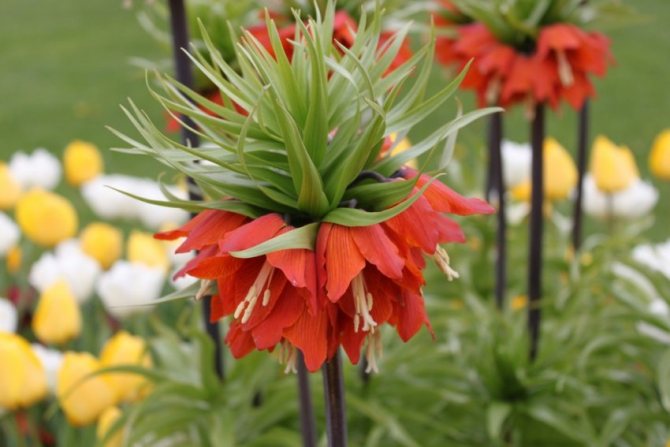

The height of the stem of the hazel grouse can reach 1 m.
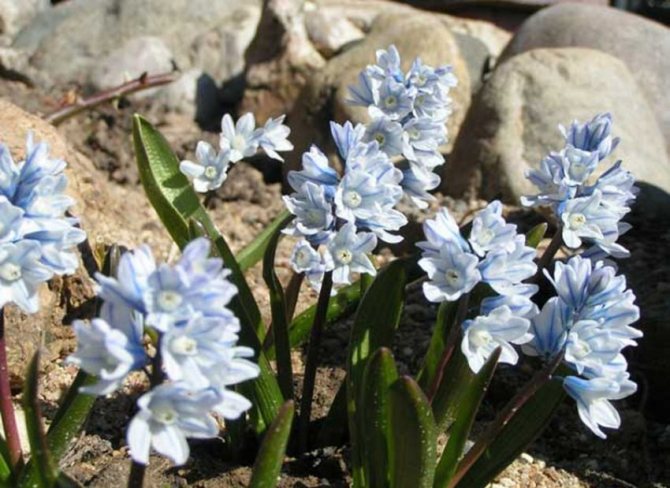

Pushkinia can have white or blue flowers.
Pushkinia
It is a bulbous plant. It is planted together with other early spring bulbous plants. Pushkinia loves light and good soil drainage. It is divided into two types:
- Proleskovidny Pushkinia has basal leaves. It grows up to 30 cm. It blooms in March-April. Inflorescences in the form of white or blue bells;
- hyacinth cannon. The hyacinth has blue or white flowers up to 10-15 cm high. The inflorescence contains from 12 to 30 flowers. Blooms in May.
Physalisoid bladder
It is a perennial with numerous leaves, which blooms with bushes up to 20 cm high. Flowers of purple color are collected at the top in the form of umbrellas. Leaves of amazing bluish color. The plant is unpretentious to care for, but it is better to plant it in a sunny place. Blooms in April-May. After that, in place of the flowers, seeds are formed in the form of balls. Long after flowering, the physalis bubblewort will delight you with its unusual leaves.
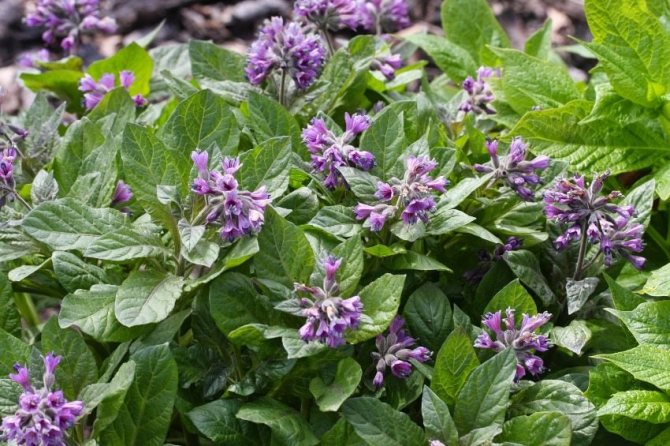

Physalisoid bladder grows in low bushes.
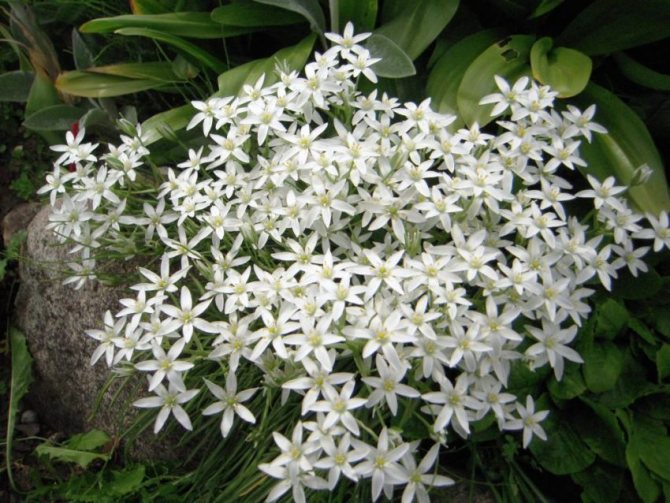

The birdhouse (ornithogalum) is best planted in a sunny place.
Poultry
This plant has up to 130 species. The birdhouse grows in bushes with long narrow leaves and small flowers at the top. The flowering period and color (white or yellow) depend on the species. Unpretentious in care, loves sunny places, not picky about the soil.
Lumbago
Better known as sleep herb. It has straight stems and leaves covered with fine hairs. Plant height up to 50 cm. Flowers are large in the form of bells of white, golden, purple, purple or silver colors. There are many types of lumbago:
- disclosed;
- spring;
- ordinary;
- Chinese;
- meadow;
- doubtful.
Backache loves dry soil. Therefore, they get along well on alpine slides and rockeries. There are slopes that do not allow water to linger. These flowers feel great in an open area or in light shade.
The optimal place for planting lumbago (sleep-grass) is dry soil.
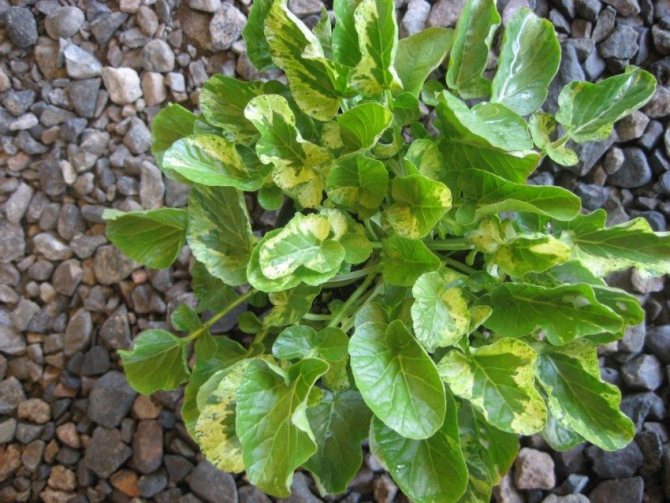

Plantain Variegata leaves have a two-colored variegated color.
Plantain
Previously, this plant was removed from the site as a weed. But with a thoughtful planting, plantain is increasingly used in decorating plots. For example, Variegata has variegated leaves. With its help, they decorate alpine slides, paths in the garden. Sunlight and moderately nutritious, well-drained soil are all a plantain needs. Photos of the use of this plant in design ideas for the garden will suggest planting options.
Gray fescue
It has very spectacular narrow and sharp blue-gray leaves that form a low (up to 60 cm) lush bush. Looks great on alpine slides.It blooms in summer with gray-green inflorescences in the form of soft panicles. Gray fescue loves warmth, sunlight and well-drained soil. The composition of the alpine slide will take on a lively look thanks to the silvery color of the fescue.
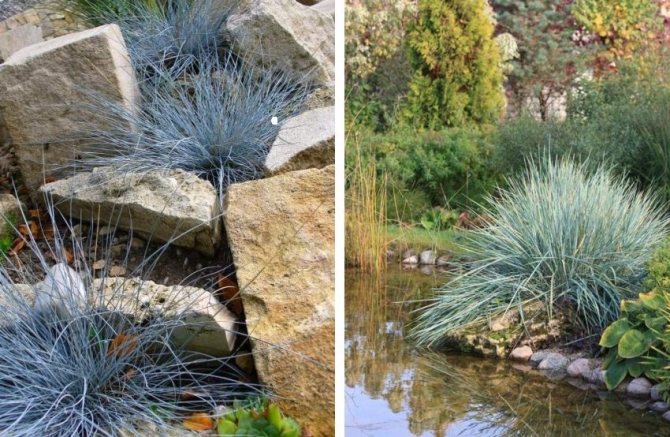

Gray fescue is often used for landscape decoration.
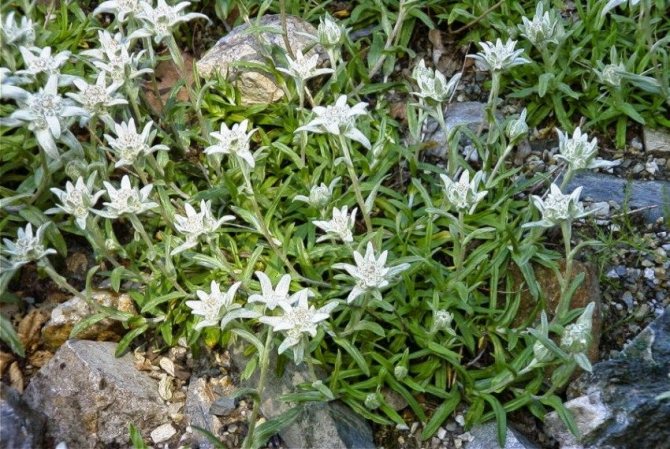

Edelweiss is usually planted on top of an alpine slide.
Alpine edelweiss
This romantic plant will be the highlight of any rock garden or rockery. Low, about 20 cm, peduncles with yellowish inflorescences-baskets. But the leaves give edelweiss a special charm. Their shape in the form of a star in a silvery-ash color looks great in landscape landscapes. This flower loves light, so its place is at the top of the hill.
On a note! Edelweiss is considered the flower of loyalty and love. According to legend, he grew up on the rocks, from which a young man and a girl in love rushed to avoid separation.
Likhnis
The people call it "dawn". Refers to perennial herbaceous plants. Feels great near water bodies. Used mainly for mixborders. Low-growing alpine lychnis is suitable for alpine slides. This plant requires moderate, regular watering. It must be transplanted to another place after 3-4 years.
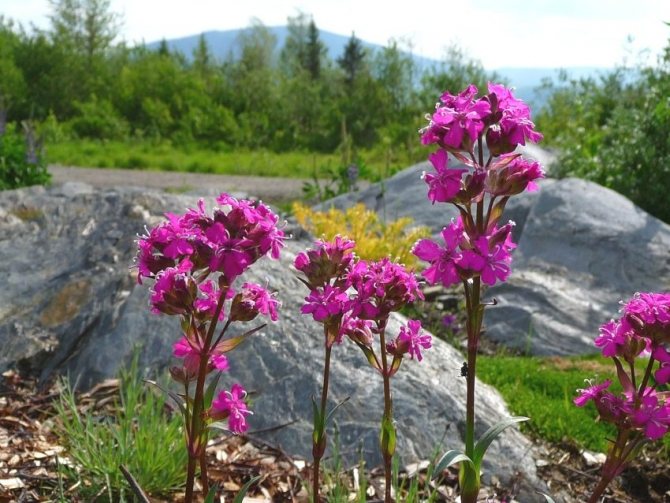

Bright pink inflorescences of Viscaria Lychnis.
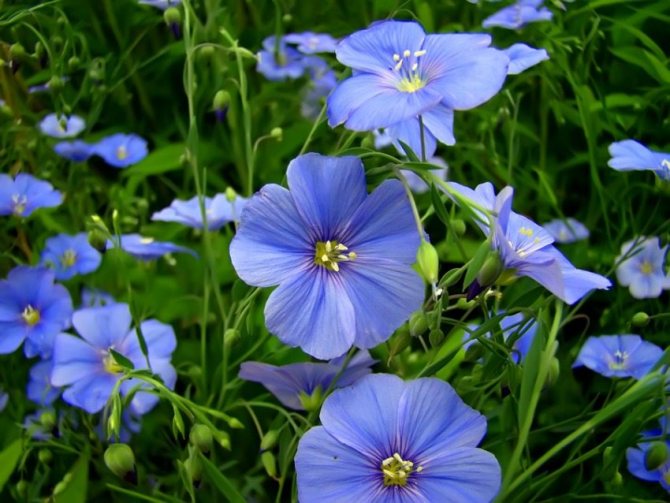

Flax has about 25 varieties and varieties.
Linen
Depending on the species, it can be a perennial, annual or subshrub. For decorative purposes, about 25 species are used. Large-flowered flax is mainly used for decorating alpine slides. A photo of different varieties of flowers (blue sky, charm salmon, charm crimson, clear eyes) will help you choose a plant in accordance with personal preferences.
The flowering of delicate flax looks great against the background of stones. The height of the stem of the large-flowered species is about 60 cm. The plant likes well-lit or slightly shaded places with poor loose soil.
Bloodroot
Rhizome or herbaceous plants, can grow as a subshrub. The species determines the growth period (annual, perennial), as well as the height of the stems. There are high ones (up to 1.5 m), they are used for flower beds and hedges. Low and creeping species are planted on alpine slides and rockeries. There is a pink, purple cinquefoil. Photos of examples of the use of this plant in gardening will suggest planting options. The flowering period is from May to July.
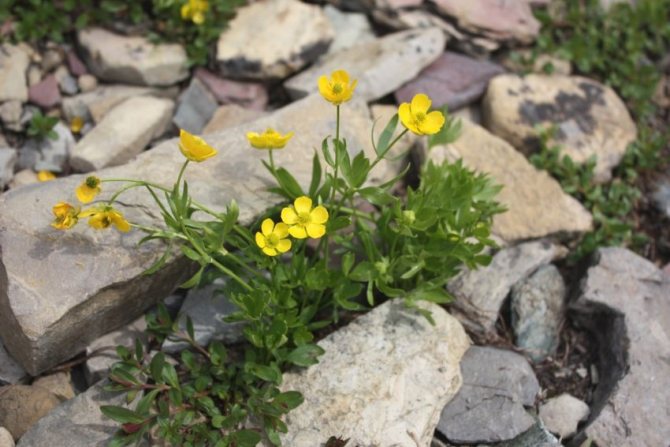

For an alpine slide, it is better to choose a low-growing cinquefoil.
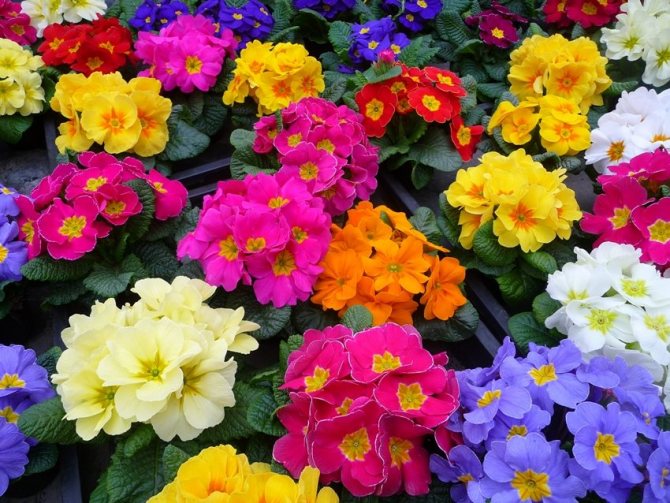

Primrose flowers can have a wide variety of colors.
Primroses
In natural conditions, these flowers prefer shaded places on mountain slopes, in crevices of rocks in the vicinity of bushes and trees. Therefore, primroses will perfectly take root among rockery stones or on an alpine slide. Among landscape designers, primroses are popular because of the variety of species and colors.
Iberis
About 30 species of plants of this genus combine annuals, perennials and shrubs. Flowering period May-June. Iberis inflorescences can be pink, lilac, white. Ornamental varieties can be red. The plant is unpretentious in care, loves dry, loose soil. Open areas, sun or partial shade are the best place for Iberis. Photos of decorating alpine slides with Iberis demonstrate the organic nature of this plant against a stone background.
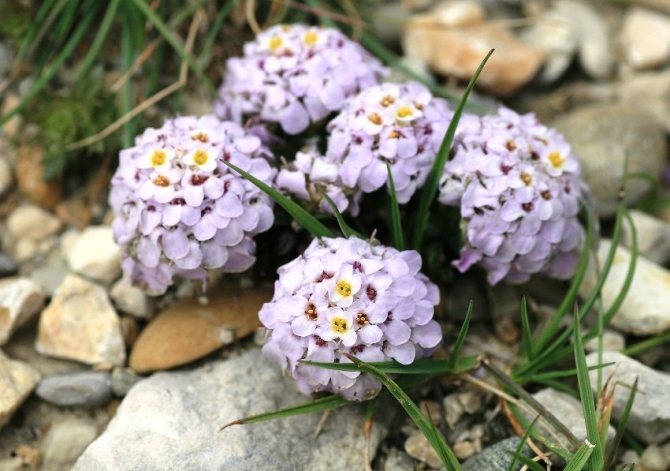

Iberis flowers look great on an alpine slide. Kupena has long stems with small white flowers.
Kupena
Perennial herb of the lily family. It has an arched stem, large leaves and white flowers in the form of small bells. The photo of the kupena shows that their placement along the stem gives the impression of gentle dew. Plant height up to 60 cm. Kupena loves moist, but without stagnant water, soil. The alpine slide is a great place for her.
Sedum (sedum)
Has more than 500 species with flowers that are not similar to each other.It can grow as a herbaceous perennial or undersized shrub. Stonecrop inflorescences are in the form of umbrellas or single, the color is the most diverse. They love the sun, but they feel quite comfortable in shaded areas. Sedum is unpretentious to the soil, does not require high humidity and can grow even on rocky slopes.
The variety and unpretentiousness makes them indispensable in decorating mixborders, alpine slides and rockeries. The photo of sedum plants of different types shows how versatile and original these plants can be.
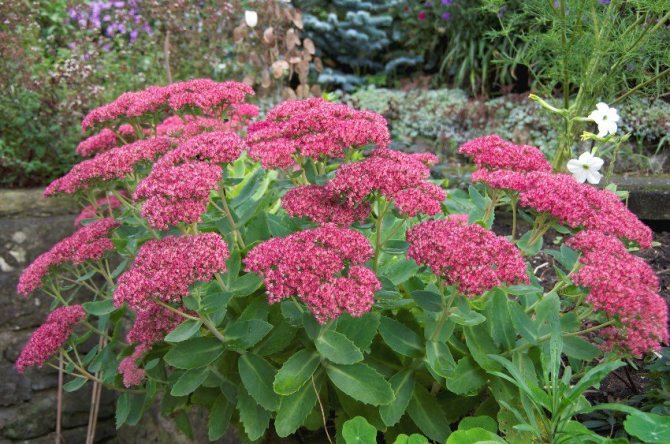

Sedum (sedum) is used to decorate mixborders and alpine slides.
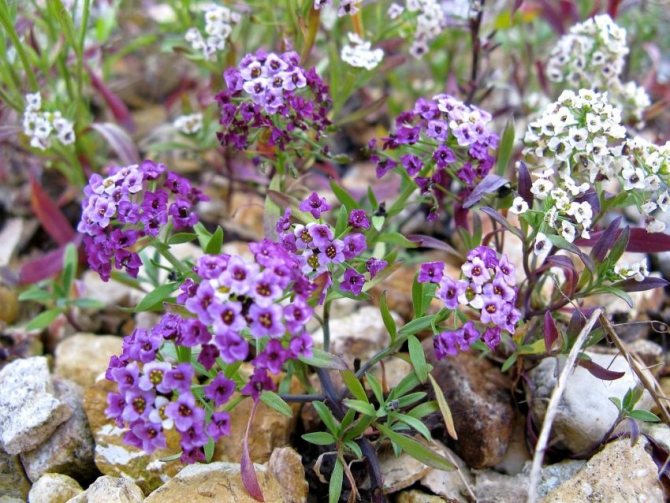

Rock Alyssum looks beautiful on alpine slides and rockeries.
Rock alyssum
Another suitable plant for an alpine slide is rock alyssum. Here are several varieties of this plant:
- the plenum has a small stature and small double flowers;
- compactum grows up to 18 cm and has small inflorescences;
- citrinum - low alyssum with yellow flowers;
- the golden wave also has yellow flowers. Plant height reaches 20 cm.
Alyssum rock flowers have a strong pleasant aroma. The plant itself is compact, loves well-lit areas, fertile soil and good drainage. Between warm stones in well-fertilized soil, it produces abundant greenery.
Rejuvenated
The plant is popularly called "stone rose" for its unusual original appearance. And in translation from the Latin language it means "forever living". One of the most used plant species in the decoration of alpine slides. The shape and size of the rosettes are diverse. The color can be pink, green, yellow, crimson, burgundy. Moreover, the same flower can change color depending on climatic conditions.
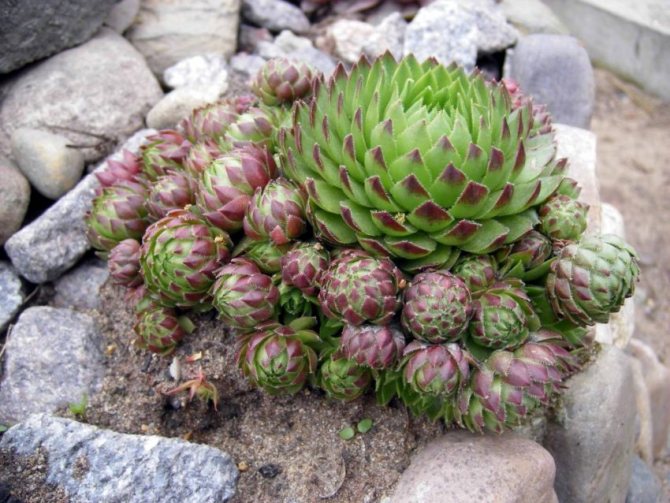

Stone rose (rejuvenated) will become an adornment of any rock garden.
This groundcover species grows to create a unique plant carpet of succulent thick leaves collected in a rosette. Due to the moisture-absorbing properties of the leaves, the plant is drought-resistant and thrives on rocky slopes.
Alpine slide in the country: photo examples of finished compositions
Alpine slides are an excellent choice when decorating the landscape design of the site of a country house, summer cottage. Experienced landscape designers argue that if the slide looks harmonious, even if not a single plant has been planted on it, then its arrangement can be considered complete.


Alpine slide.
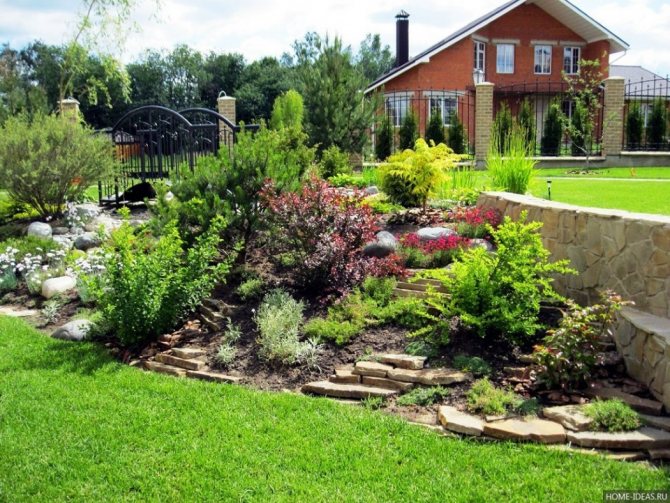

Alpine slide.
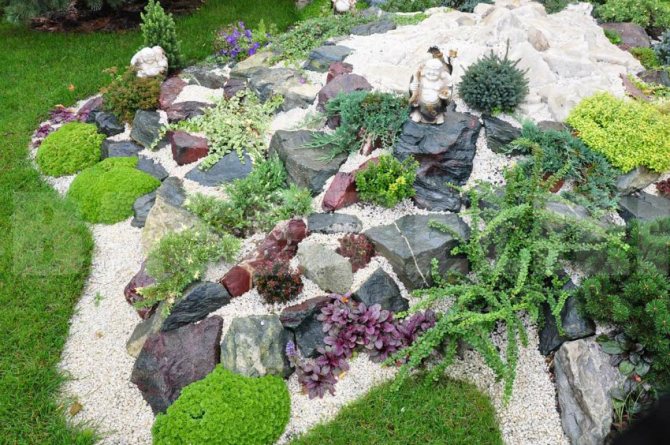

Alpine slide. Alpine slide.
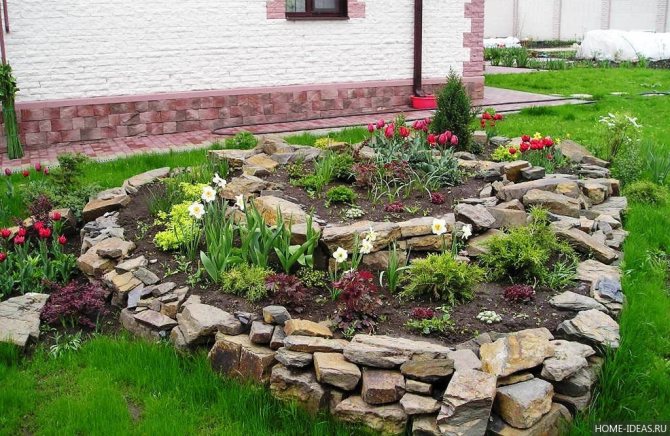

Alpine slide.
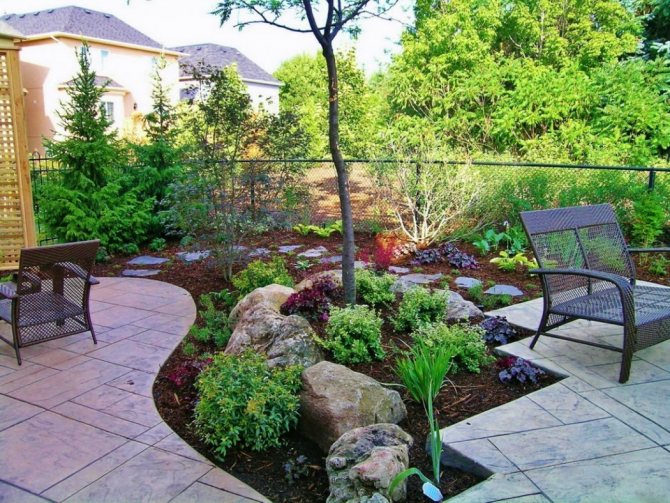

Alpine slide.
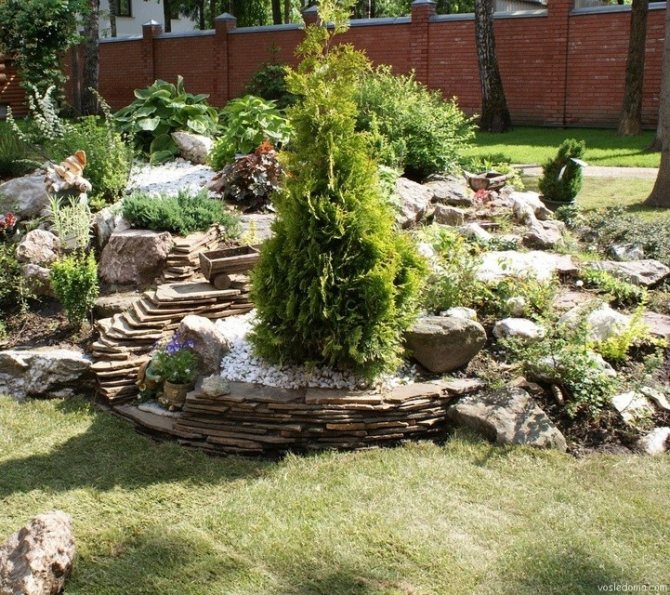

Alpine slide.
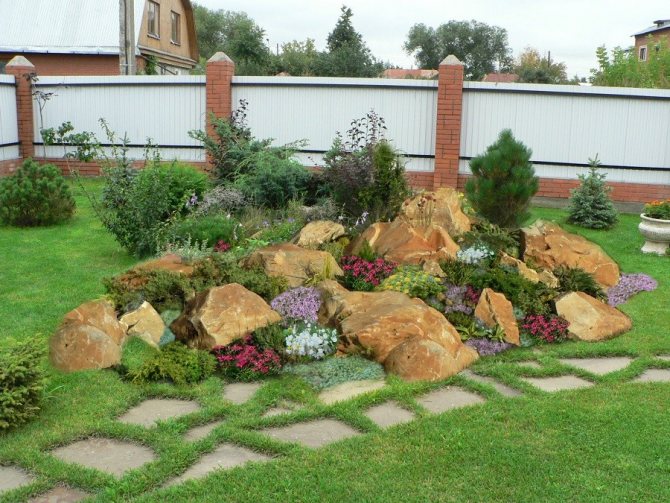

Alpine slide.


Alpine slide.
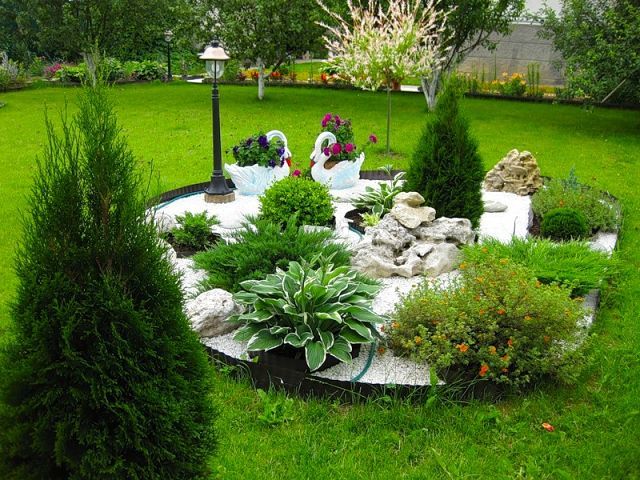

Alpine slide.
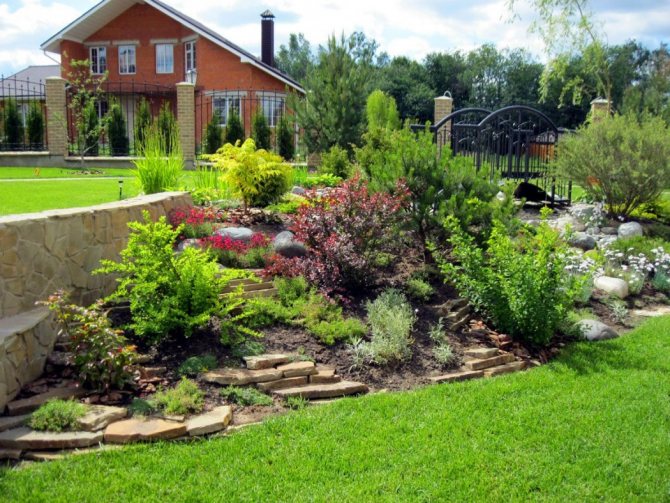

Alpine slide.
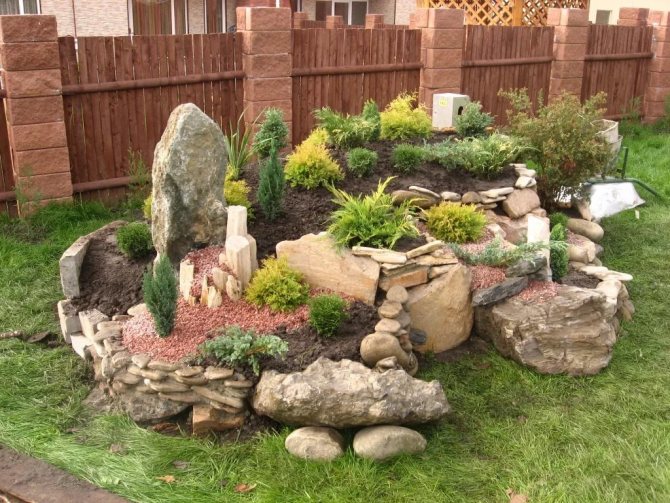

Alpine slide.
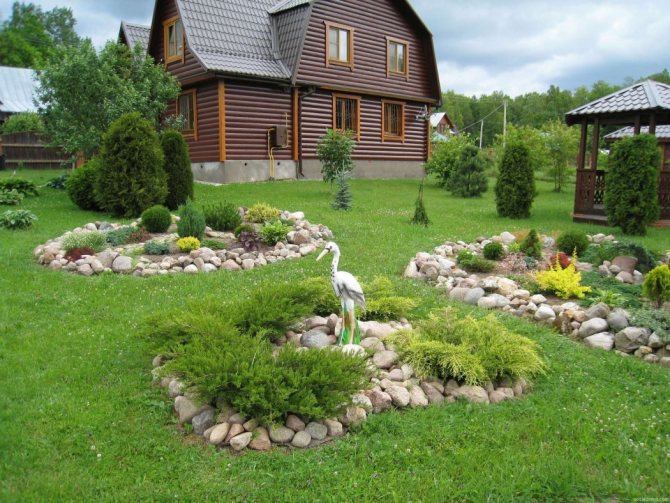

Alpine slide.
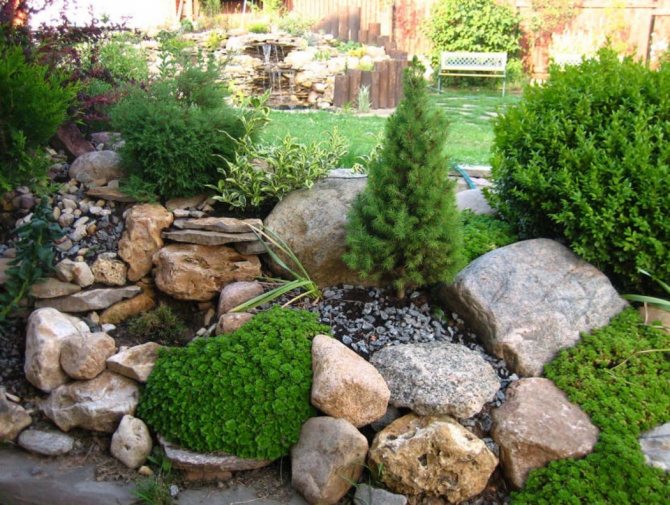

Alpine slide.
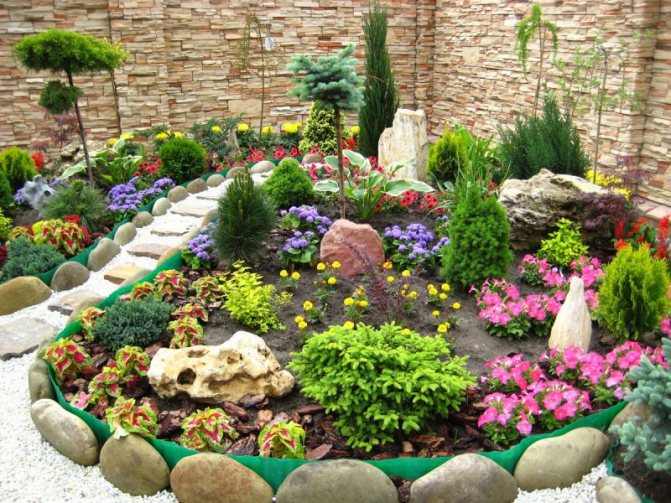

Alpine slide.
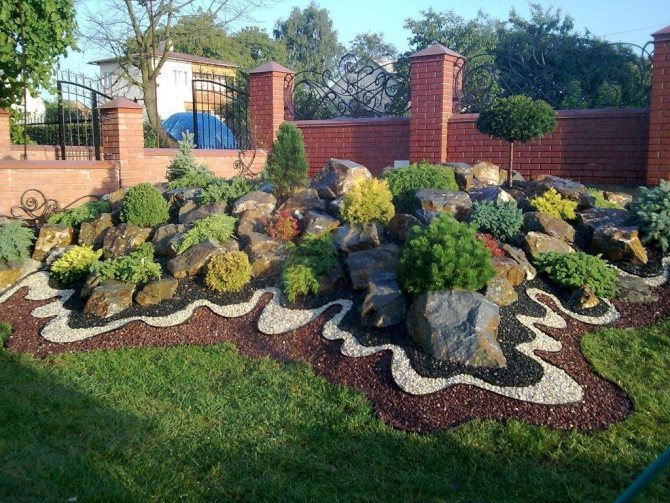

Alpine slide.
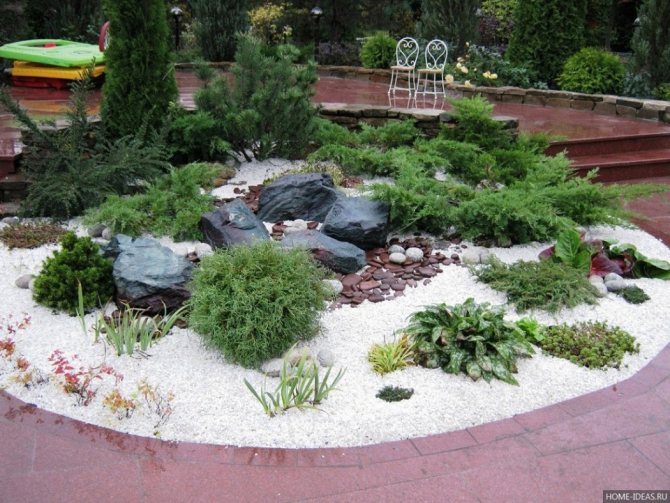

Alpine slide. Alpine slide.
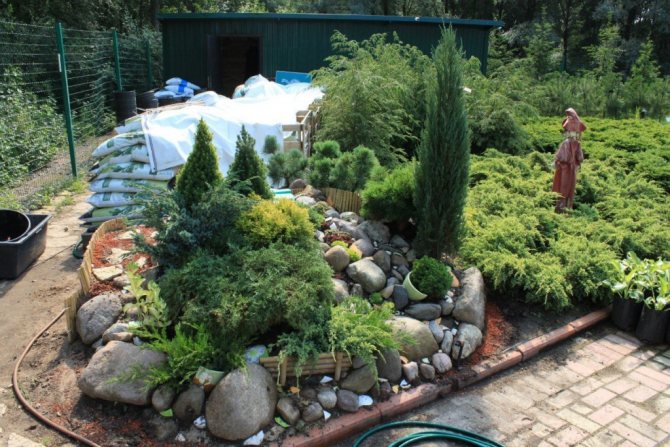

Alpine slide.
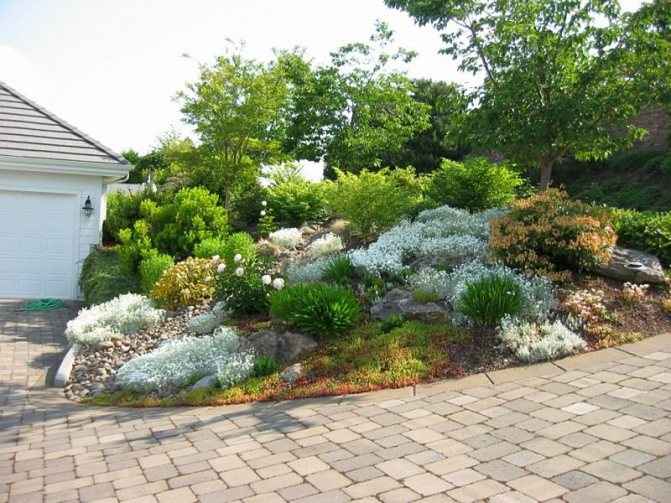

Alpine slide.
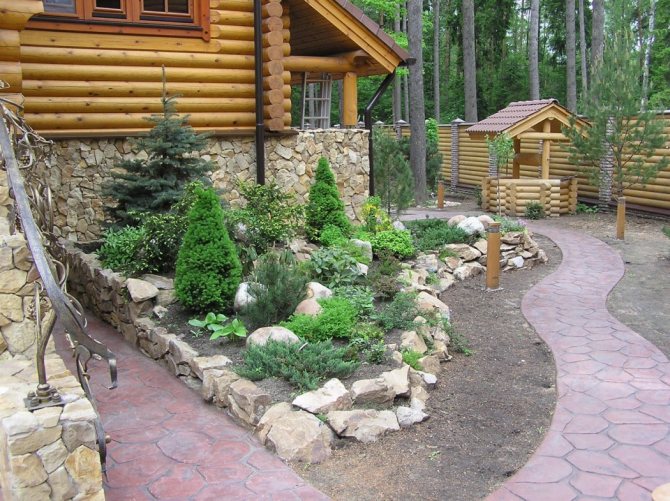

Alpine slide.
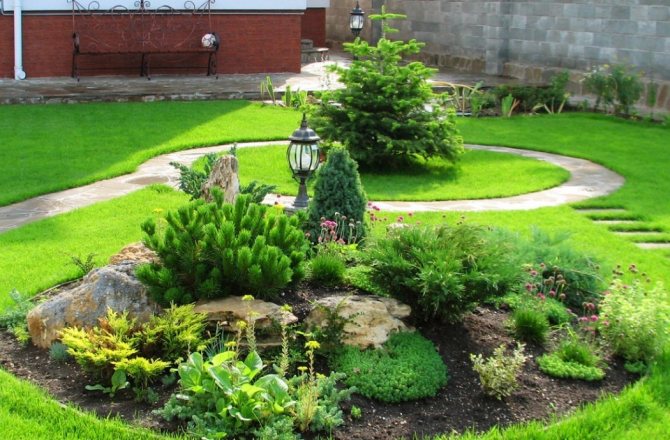

Alpine slide.
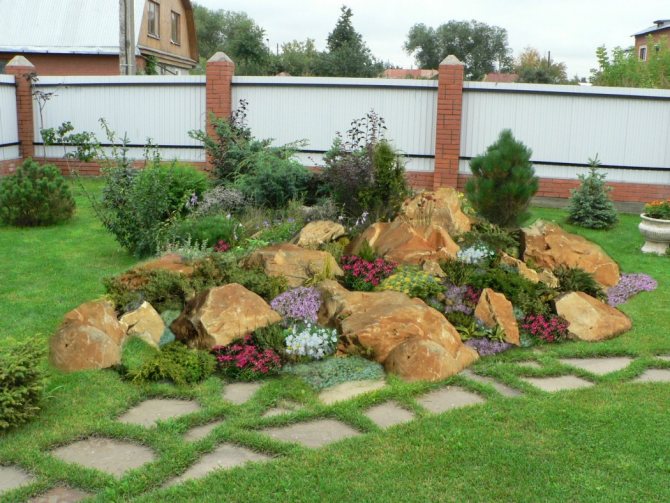

Alpine slide.
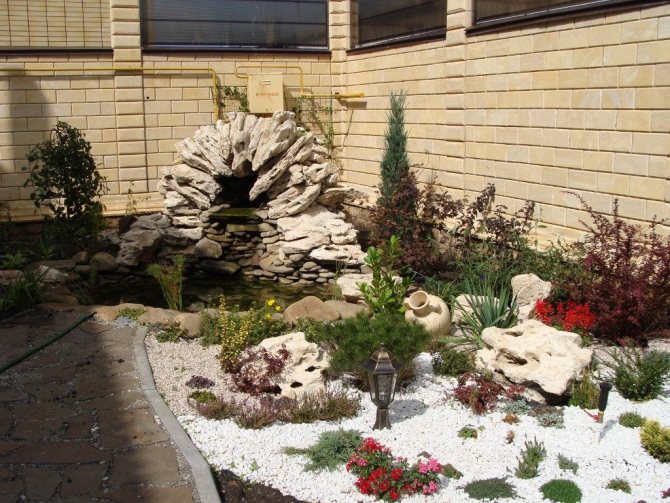

Alpine slide.
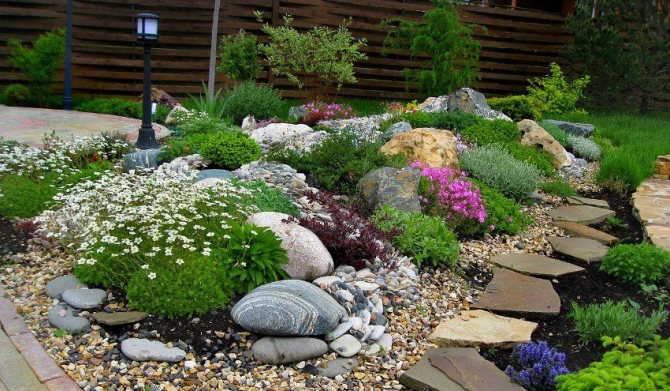

Alpine slide.
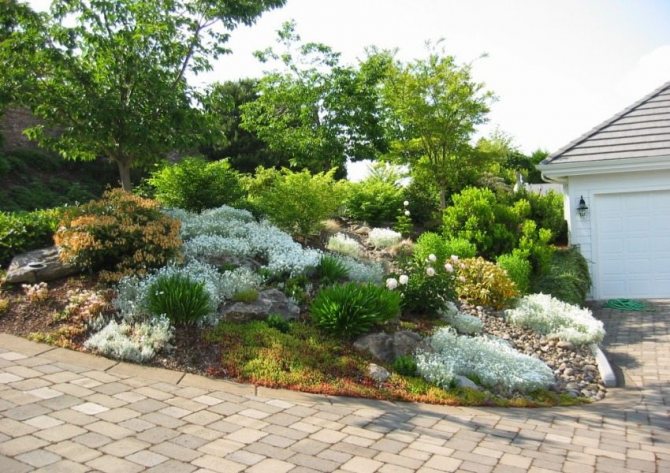

Alpine slide.
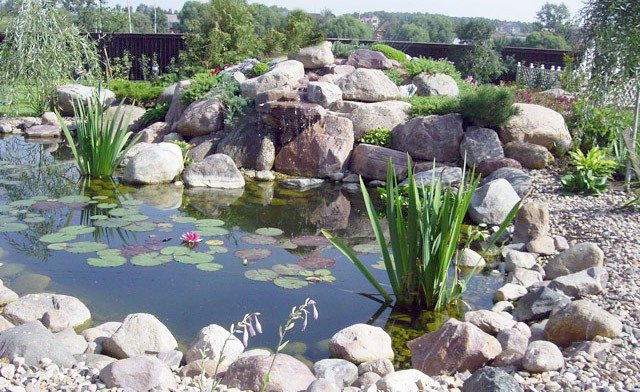

Alpine slide.
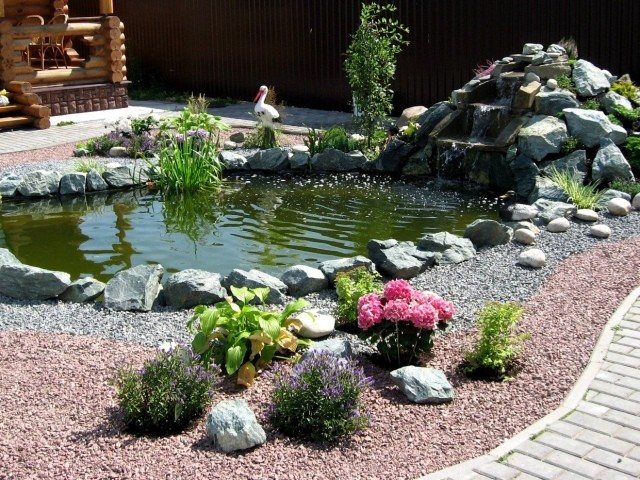

Alpine slide.
Some gardeners try to combine an alpine slide with a pond. Step-by-step photos of such structures show the complexity of the process, divided into a large number of stages. However, having some skills, you can try to arrange such beauty yourself. Of course, this process takes more than one day, in some cases, when creating an alpine slide, the final result in full splendor can only be seen after several years, since some plants take time to adapt to a new place.
"Forest ravine"
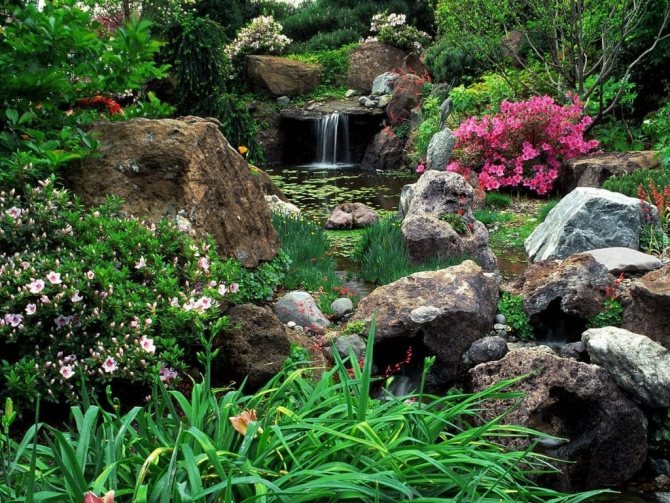

An extremely atypical type of alpine slide is the "forest ravine". Such a rock garden is not located on a hill, like most, but, on the contrary, in a depression. Here, more attention is paid to imitation of forest space, therefore, dimensional stones are used, abundantly covered with moss and decorated with many plants.It is also possible to arrange a small pond near the slide, as shown in the photo below. This element will add a mysterious expressiveness to your garden plot.

